#christian schwarzenberger
Explore tagged Tumblr posts
Text
Sukob oko troškova grijanja u Münchenu se nastavlja: Stanari protiv Münchner Wohnen
Stanari iz Münchena, posebno iz gradskih četvrti Hasenbergl i Harthof, već mjesecima vode borbu s gradskom stambenom agencijom Münchner Wohnen (MW) zbog sporne naplate troškova grijanja. Slučaj se dodatno zakomplicirao u ožujku, kada je tvrtka počela selektivno vraćati novac pojedinim stanarima, dok su drugi ostali zakinuti – iako imaju isti pravni osnov za povrat. Provjeri još i… Kako je došlo…
#ödp münchen#christian schwarzenberger#Die Linke#gradski stanovi münchen#grijanje i topla voda#grijanje münchen#harthof#hasenbergl#münchner wohnen#mw skandal#nadzorni odbor mw#politička kriza münchen#povrat troškova grijanja#stanari münchen
0 notes
Text

PERRET SCHAAD S/S2014, Foto Christian Schwarzenberg, Show location Neuw Nationalgalerie
0 notes
Text



The Richman Brothers Company Factory Building
1600 E. 55th St.
Cleveland, OH
The Richman Brothers Company was originally founded by Jewish-Bavarian immigrant Henry Richman Sr. and his brother-in-law and business partner Joseph Lehman in Portsmouth, Ohio, in 1853. In an effort to become closer to a bustling city, both to expand their operations and customer base, the two men relocated with their families and business to Cleveland, Ohio, in 1879. Originally named the Lehman-Richman Company, the operation took on the moniker the Richman Brothers Company in 1904 after both Henry Richman Sr. and Joseph Lehman had retired and transferred ownership of the company to Henry Sr.’s three sons Nathan, Charles and Henry Jr.
After having a presence in the region for nearly forty years, the Richman Brothers Company commissioned their first Cleveland factory to be built at 1600 East 55th Street after previously retrofitting their operations into several other pre-existing structures throughout the city. Designed by The Christian Schwarzenberg and Gaede Company and constructed by Hunkin-Conkey Construction Co., the building was designated the “Best Built Factory in Cleveland in 1917” by the Cleveland Chamber of Commerce. Later additions were added onto the structure in 1924 and 1927, which completed the 650,000 square feet of interior space still present on the site.
The factory quickly became a landmark on the East 55th Street landscape as a result of its domineering size, both inside and out. With fifteen-foot-high ceilings, large-scale windows, and even the world’s largest cutting tables at the time, measuring sixty feet long, the structure provided Richman Brothers’ employees with working conditions previously unheard of in the garment industry.
Not only were Clevelanders familiar with the building, so, too, was the federal government. After entry into World War I, the federal government approached the brothers with a proposition to turn the site over to a military occupation to be used as a hospital for returning injured soldiers. After only one year of owning the building, in 1918 the Richman Brothers readily agreed to allow the government to utilize the structure as needed, making Cleveland the first city in the country to place such a building at the government’s disposal without expense.
Their commitment to the war effort was just one element of the Richman Brothers’ reputable business practices. As a family owned and operated company, the Richman Brothers ensured that each person under their employ felt as though they were part of a family. The first industrial organization to do so, the Richman Brothers Company offered two weeks paid vacation for all employees. Similarly, the company also instituted paid maternity leave, set a thirty-six hour work week, utilized no time clocks, and offered corporate stock options. To assist employees during times of personal distress, The Richman Brothers Foundation was created which provided no interest loans to employees as needed. The brothers were viewed as such progressives that the federal government based many workplace regulation laws off of Richman standards.
The Richman Brothers also tirelessly fought to keep the unions out of their company. Pressures mounted around the middle of the twentieth century, which resulted in the company releasing a statement saying, “The union plan . . . has been one to crush our business. We think this is wrong . . . to put this kind of pressure on our family.” Confident in their business practices, the Richman Brothers believed the union to be unnecessary and felt it would restrict the benefits they were able to offer their employees.
While the name of the company implies that all three brothers were equally in control of the company, it is Nathan Richman who is credited with maintaining the company’s standards and growing the business into one of the largest men’s clothing retailers in the country. At the time of his death in 1941, two thousand employees gathered at the open-casket services to bid farewell to the last surviving Richman brother.
After Nathan’s death the company remained under the ownership of one of his nephews, who continued to successfully grow and expand the business. In 1969, the Richman Brothers merged with F. W. Woolworth Company, who kept the Richman brand viable for another three decades. As the industry changed sharply in the late 1980s, the bloated conglomerate Woolworth began to shutter some of its subsidiaries. In 1990, the Richman Brothers Company was deemed financially unstable and was completely liquidated by 1992. Since that time, the structure on East 55th Street has remained vacant with many unsuccessful reuse projects proposed to redevelop the site. The abandoned Richman Brothers Company factory, built in 1916 and located at 1600 E. 55th Street in Cleveland, Ohio, was listed the National Register of Historic Places on September 19, 2012.
0 notes
Text
Holidays 8.24
Holidays
Bartholomew Fair (UK)
Day of Action for Tolerance & Respect Among Peoples (Argentina)
Flag Day (Liberia)
Flitting Appreciation Day
Gaura Parba (Nepal)
Go Topless Day [also Sunday nearest 8.26]
International Day Against Intolerance, Discrimination and Violence Based on Musical Preferences, Lifestyle and Dress Code (UN)
International Strange Music Day
Knife Day
Kobe Bryant Day (Los Angeles)
Love a Geek Day
Minerva Asteroid Day
National #IAM911 Day
National Danny Day
National Emory Day
National Hydropower Day
National Knife Day
National Maryland Day
National Parks Day (Costa Rica)
National SKAM Artist Day
National Waffle Iron Day
Nostalgia Night (Uruguay)
Osiris Nativity (Ancient Egypt)
Pluto Demotion Day
Sam Spade Day
Schaferlauf (Germany)
Shooting Star Day
Single-Parent Family Day
Television Day Indonesia)
Vesuvius Day
Waffle Iron Day
Waratambar (Thanksgiving; Papua New Guinea)
Wayzgoose (End-of-Summer Party)
Weather Complaint Day
We Love Memoirs Day
William Wilberforce Day
Winter Barley Day (French Republic)
World Catholic, Artificial Intelligence, & Robot Day
World Gujarati Language Day
World Nuclear Disaster Day
World Trainer’s Day
Food & Drink Celebrations
Can-Opener Day
Indian Single Malt Day
National Peach Pie Day
National Waffle Day
Independence & Related Days
Russia (from USSR, 1991)
Ukraine (from USSR, 1991)
4th Saturday in August
Bartletide (a.k.a. Burning Bartle; UK) [Saturday closest to 24th]
Sandwich Saturday [Every Saturday]
Six For Saturday [Every Saturday]
Spaghetti Saturday [Every Saturday]
Speak Kind Words Saturday [Saturday of Be Kind to Humankind Week]
Weekly Holidays beginning August 24 (3rd Full Week of August)
Giants of Ath Festival (De Ducasse; Belgium) [4th Saturday thru SUnday]
International Bat Nights (thru 8.25) [Last Full Weekend]
Festivals Beginning August 24, 2024
Around The World Cultural Food Festival (Alexandria, Virginia)
Balingup Medieval Carnivale (Balingup, Australia) [thru 8.25]
Banana Split Celebration (Latrobe, Pennsylvania) [thru 8.25]
Beertopia(Palmetto, Florida)
Bloemencorso Vollenhove (Vollenhove, Netherlands)
Boones Mill Apple Festival (Boones Mill, Virginia)
Boston’s Trinidad Style Carnival (Boston, Massachusetts)
Brew at the Zoo (Providence, Rhode Island)
Cleveland Garlic Festival (Cleveland, Ohio) [thru 8.25]
Coastal Craft Beer Festival (Virginia Beach, Virginia)
Delaware Beer, Wine and Spirits Festival (Dover, Delaware)
Farm Fresh Uncorked (Hillsboro, Oregon)
Heirloom Tomato Festival (Sherman, Connecticut)
Independence BrewBQ (Independence, Iowa)
Lake Tahoe Brewfest (Lake Tahoe, California)
Long Night of Museums (Berlin, Germany)
Music City Brewer's Fest (Nashville, Tennessee)
National Championship Chuckwagon Race (Clinton, Arkansas) [thru 9.1]
Olathe Sweet Corn Festival (Olathe, Colorado)
Pittsburgh Renaissance Festival (West Newton, Pennsylvania) [thru 9.28]
Potwin Watermelon Festival (Potwin, Kansas)
Prickly Pear Festival (Superior, Arizona)
Prosser Beer & Whiskey Festival (Prosser, Washington)
Sawtooth Salmon Festival (Stanley, Idaho)
Schubertiade Vorarlberg (Schwarzenberg, Austria) [thru 9.1]
ShakesBeer Fest (Stratford, Connecticut)
Smuttynose Food Truck & Craft Beer Festival (Hampton, New Hampshire)
Swine in the Pines (Macclenny, Florida)
Threshing Bee (Donnelly, Minnesota) [thru 8.25]
Washington County Fair (Pembroke, Maine) [thru 8.25]
Wells Chili-Fest (Wells, Maine)
West Virginia State Honey Festival (Parkersburg, West Virginia) [thru 8.25]
Windsor Fair (Windsor, Maine) [thru 9.2]
Wine Down Summer (West Deptford, New Jersey)
Feast Days
Abbán of Ireland (Christian; Saint)
Alexander Milne Calder (Artology)
Alex Colville (Artology)
Arkwright (Positivist; Saint)
A.S. Byatt (Writerism)
Aubrey Beardsley Day (Church of the SubGenius; Saint)
Aurea of Ostia (Christian; Saint)
Bartholomew the Apostle (Roman Catholic, Anglican) [mead drinkers, cheese merchants] *
Day of Our Lady of Sanity (Pagan)
Festival of Mania (Ancient Rome)
Gartan (Celtic Book of Days)
The Great In-Betweeny (Muppetism)
Gunnlöð Festival (Norse)
Hannah Frank (Artology)
Irchard (a.k.a. Erthad) of Scotland (Christian; Saint)
Jeanne-Antide Thouret (Christian; Saint)
Jorge Luis Borges (Writerism)
Lavinia Fontana (Artology)
Luna Festival (Ancient Rome)
Maria Micaela Desmaisieres (Christian; Saint)
The Martyrs of Utica (Christian; Martyrs)
Massa Candida (Martyrs of Utica, a.k.a. The White Mass; Christian; Martyrs)
Magal de Touba (Pilgrimmage; Senegal)
Mundus Patet (Roman Harvest Feast)
Mundus Ritual of Ceres (Starza Pagan Book of Days)
Nancy Spero (Artology)
Ouen (Audoin or Audoenus) of Rouen (Christian; Saint) [Innkeepers]
Paul Coelho (Writerism)
Pluto Demotion Grieving Day (Pastafarian)
Stephen Fry (Humanism; Writerism)
Willka Raymi (Ancient Incan; Peru)
Lucky & Unlucky Days
Sakimake (先負 Japan) [Bad luck in the morning, good luck in the afternoon.]
Premieres
Alice’s Restaurant (Film; 1969)
All Quiet on the Western Front (Film; 1930)
Buddy the Gee Man (WB LT Cartoon; 1935)
Chop Suey (Terrytoons Cartoon; 1930)
Chronic Town, by R.E.M. (EP; 1982)
The Facts of Life (TV Series; 1979)
Fantastic Voyage (Film; 1966)
The Fox and the Duck (Terrytoons Cartoon; 1945)
Frank, by Squeeze (Album; 1989)
Get Together, recorded by The Youngbloods (Song; 1966)
Grace, by Jeff Buckley (Album; 1994)
Gravity and Grace, by Simone Weil (Philosophical Thoughts; 1947)
They Happytime Murders (Film; 2018)
The Harp in the South, by Ruth Park (Novel; 1948)
Hi-Rise Wise Guys (Woody Woodpecker Cartoon; 1970)
Jay and Silent Bob Stroke Back (Film; 2001)
Look What You Made Me Do, by Taylor Swift (Song; 2017)
Love Me Tender, recorded by Elvis Presley (Song; 1956)
Mess Production (Fleischer/Famous Popeye Cartoon; 1945)
Mice in Council (Terrytoons Cartoon; 1934)
Mockingjay, by Suzanne Collins (Novel; 2010) [#3]
Oh! The Grandeur, by Andrew Bird with Bowl of Fire (Album; 1999)
Pump Up the Volume (Film; 1990)
Rock ’N’ Roll High School (Film; 1979)
Rosencrantz and Guildenstern Are Dead, by Tom Stoppard (Play; 1966)
Saludos Amigos (Disney Animated Film; 1942)
Taran Wanderer, by Lloyd Alexander [Chronicles of Prydain #4]
Tattoo You, by The Rolling Stones (Album; 1981)
Teenage Dream, by Katy Perry (Album; 2010)
3 Ring Wing-Ding (WB LT Cartoon; 1968)
Tortilla Soup (Film; 2001)
Violin and Piano Sonata (K526), by Wolfgang Amadeus Mozart (Sonata; 1787)
The Witches (Film; 1990)
Today’s Name Days
Bartholomäus, Isolde, Michaela (Austria)
Aurea, Bariša, Bartol, Bartolomej, Bartul, Zlata (Croatia)
Bartoloměj (Czech Republic)
Bartholomæus (Denmark)
Albert, Berta, Pärt, Pärtel (Estonia)
Bertta, Perttu (Finland)
Barthélémy (France)
Bartholomäus, Isolde, Michaela (Germany)
Aitolia, Eftihis (Greece)
Bertalan (Hungary)
Bartolomeo, Genesio, Giuliano (Italy)
Bertolds, Bertrams, Berts, Bertulis, Boleslavs (Latvia)
Alicija, Baltramiejus, Baltrus, Rasuolė, Viešvilas (Lithuania)
Belinda, Bertil (Norway)
Bartłomiej, Cieszymir, Jerzy, Joanna, Malina, Michalina (Poland)
Bartolomej (Slovakia)
Bartolomé, Emilia (Spain)
Bartolomeus (Sweden)
Baird, Bard, Bart, Barth, Bartholomew, Bowen, Evan, Ewan, Keon, Owen (USA)
Today is Also���
Day of Year: Day 237 of 2024; 129 days remaining in the year
ISO: Day 6 of Week 34 of 2024
Celtic Tree Calendar: Coll (Hazel) [Day 22 of 28]
Chinese: Month 7 (Ren-Shen), Day 21 (Geng-Shen)
Chinese Year of the: Dragon 4722 (until January 29, 2025) [Wu-Chen]
Hebrew: 20 Av 5784
Islamic: 18 Safar 1446
J Cal: 27 Purple; Sixday [27 of 30]
Julian: 11 August 2024
Moon: 68%: Waning Gibbous
Positivist: 12 Gutenberg (9th Month) [Arkwright]
Runic Half Month: Rad (Motion) [Day 2 of 15]
Season: Summer (Day 66 of 94)
Week: 3rd Full Week of August
Zodiac: Virgo (Day 3 of 32)
0 notes
Text
Holidays 8.24
Holidays
Bartholomew Fair (UK)
Day of Action for Tolerance & Respect Among Peoples (Argentina)
Flag Day (Liberia)
Flitting Appreciation Day
Gaura Parba (Nepal)
Go Topless Day [also Sunday nearest 8.26]
International Day Against Intolerance, Discrimination and Violence Based on Musical Preferences, Lifestyle and Dress Code (UN)
International Strange Music Day
Knife Day
Kobe Bryant Day (Los Angeles)
Love a Geek Day
Minerva Asteroid Day
National #IAM911 Day
National Danny Day
National Emory Day
National Hydropower Day
National Knife Day
National Maryland Day
National Parks Day (Costa Rica)
National SKAM Artist Day
National Waffle Iron Day
Nostalgia Night (Uruguay)
Osiris Nativity (Ancient Egypt)
Pluto Demotion Day
Sam Spade Day
Schaferlauf (Germany)
Shooting Star Day
Single-Parent Family Day
Television Day Indonesia)
Vesuvius Day
Waffle Iron Day
Waratambar (Thanksgiving; Papua New Guinea)
Wayzgoose (End-of-Summer Party)
Weather Complaint Day
We Love Memoirs Day
William Wilberforce Day
Winter Barley Day (French Republic)
World Catholic, Artificial Intelligence, & Robot Day
World Gujarati Language Day
World Nuclear Disaster Day
World Trainer’s Day
Food & Drink Celebrations
Can-Opener Day
Indian Single Malt Day
National Peach Pie Day
National Waffle Day
Independence & Related Days
Russia (from USSR, 1991)
Ukraine (from USSR, 1991)
4th Saturday in August
Bartletide (a.k.a. Burning Bartle; UK) [Saturday closest to 24th]
Sandwich Saturday [Every Saturday]
Six For Saturday [Every Saturday]
Spaghetti Saturday [Every Saturday]
Speak Kind Words Saturday [Saturday of Be Kind to Humankind Week]
Weekly Holidays beginning August 24 (3rd Full Week of August)
Giants of Ath Festival (De Ducasse; Belgium) [4th Saturday thru SUnday]
International Bat Nights (thru 8.25) [Last Full Weekend]
Festivals Beginning August 24, 2024
Around The World Cultural Food Festival (Alexandria, Virginia)
Balingup Medieval Carnivale (Balingup, Australia) [thru 8.25]
Banana Split Celebration (Latrobe, Pennsylvania) [thru 8.25]
Beertopia(Palmetto, Florida)
Bloemencorso Vollenhove (Vollenhove, Netherlands)
Boones Mill Apple Festival (Boones Mill, Virginia)
Boston’s Trinidad Style Carnival (Boston, Massachusetts)
Brew at the Zoo (Providence, Rhode Island)
Cleveland Garlic Festival (Cleveland, Ohio) [thru 8.25]
Coastal Craft Beer Festival (Virginia Beach, Virginia)
Delaware Beer, Wine and Spirits Festival (Dover, Delaware)
Farm Fresh Uncorked (Hillsboro, Oregon)
Heirloom Tomato Festival (Sherman, Connecticut)
Independence BrewBQ (Independence, Iowa)
Lake Tahoe Brewfest (Lake Tahoe, California)
Long Night of Museums (Berlin, Germany)
Music City Brewer's Fest (Nashville, Tennessee)
National Championship Chuckwagon Race (Clinton, Arkansas) [thru 9.1]
Olathe Sweet Corn Festival (Olathe, Colorado)
Pittsburgh Renaissance Festival (West Newton, Pennsylvania) [thru 9.28]
Potwin Watermelon Festival (Potwin, Kansas)
Prickly Pear Festival (Superior, Arizona)
Prosser Beer & Whiskey Festival (Prosser, Washington)
Sawtooth Salmon Festival (Stanley, Idaho)
Schubertiade Vorarlberg (Schwarzenberg, Austria) [thru 9.1]
ShakesBeer Fest (Stratford, Connecticut)
Smuttynose Food Truck & Craft Beer Festival (Hampton, New Hampshire)
Swine in the Pines (Macclenny, Florida)
Threshing Bee (Donnelly, Minnesota) [thru 8.25]
Washington County Fair (Pembroke, Maine) [thru 8.25]
Wells Chili-Fest (Wells, Maine)
West Virginia State Honey Festival (Parkersburg, West Virginia) [thru 8.25]
Windsor Fair (Windsor, Maine) [thru 9.2]
Wine Down Summer (West Deptford, New Jersey)
Feast Days
Abbán of Ireland (Christian; Saint)
Alexander Milne Calder (Artology)
Alex Colville (Artology)
Arkwright (Positivist; Saint)
A.S. Byatt (Writerism)
Aubrey Beardsley Day (Church of the SubGenius; Saint)
Aurea of Ostia (Christian; Saint)
Bartholomew the Apostle (Roman Catholic, Anglican) [mead drinkers, cheese merchants] *
Day of Our Lady of Sanity (Pagan)
Festival of Mania (Ancient Rome)
Gartan (Celtic Book of Days)
The Great In-Betweeny (Muppetism)
Gunnlöð Festival (Norse)
Hannah Frank (Artology)
Irchard (a.k.a. Erthad) of Scotland (Christian; Saint)
Jeanne-Antide Thouret (Christian; Saint)
Jorge Luis Borges (Writerism)
Lavinia Fontana (Artology)
Luna Festival (Ancient Rome)
Maria Micaela Desmaisieres (Christian; Saint)
The Martyrs of Utica (Christian; Martyrs)
Massa Candida (Martyrs of Utica, a.k.a. The White Mass; Christian; Martyrs)
Magal de Touba (Pilgrimmage; Senegal)
Mundus Patet (Roman Harvest Feast)
Mundus Ritual of Ceres (Starza Pagan Book of Days)
Nancy Spero (Artology)
Ouen (Audoin or Audoenus) of Rouen (Christian; Saint) [Innkeepers]
Paul Coelho (Writerism)
Pluto Demotion Grieving Day (Pastafarian)
Stephen Fry (Humanism; Writerism)
Willka Raymi (Ancient Incan; Peru)
Lucky & Unlucky Days
Sakimake (先負 Japan) [Bad luck in the morning, good luck in the afternoon.]
Premieres
Alice’s Restaurant (Film; 1969)
All Quiet on the Western Front (Film; 1930)
Buddy the Gee Man (WB LT Cartoon; 1935)
Chop Suey (Terrytoons Cartoon; 1930)
Chronic Town, by R.E.M. (EP; 1982)
The Facts of Life (TV Series; 1979)
Fantastic Voyage (Film; 1966)
The Fox and the Duck (Terrytoons Cartoon; 1945)
Frank, by Squeeze (Album; 1989)
Get Together, recorded by The Youngbloods (Song; 1966)
Grace, by Jeff Buckley (Album; 1994)
Gravity and Grace, by Simone Weil (Philosophical Thoughts; 1947)
They Happytime Murders (Film; 2018)
The Harp in the South, by Ruth Park (Novel; 1948)
Hi-Rise Wise Guys (Woody Woodpecker Cartoon; 1970)
Jay and Silent Bob Stroke Back (Film; 2001)
Look What You Made Me Do, by Taylor Swift (Song; 2017)
Love Me Tender, recorded by Elvis Presley (Song; 1956)
Mess Production (Fleischer/Famous Popeye Cartoon; 1945)
Mice in Council (Terrytoons Cartoon; 1934)
Mockingjay, by Suzanne Collins (Novel; 2010) [#3]
Oh! The Grandeur, by Andrew Bird with Bowl of Fire (Album; 1999)
Pump Up the Volume (Film; 1990)
Rock ’N’ Roll High School (Film; 1979)
Rosencrantz and Guildenstern Are Dead, by Tom Stoppard (Play; 1966)
Saludos Amigos (Disney Animated Film; 1942)
Taran Wanderer, by Lloyd Alexander [Chronicles of Prydain #4]
Tattoo You, by The Rolling Stones (Album; 1981)
Teenage Dream, by Katy Perry (Album; 2010)
3 Ring Wing-Ding (WB LT Cartoon; 1968)
Tortilla Soup (Film; 2001)
Violin and Piano Sonata (K526), by Wolfgang Amadeus Mozart (Sonata; 1787)
The Witches (Film; 1990)
Today’s Name Days
Bartholomäus, Isolde, Michaela (Austria)
Aurea, Bariša, Bartol, Bartolomej, Bartul, Zlata (Croatia)
Bartoloměj (Czech Republic)
Bartholomæus (Denmark)
Albert, Berta, Pärt, Pärtel (Estonia)
Bertta, Perttu (Finland)
Barthélémy (France)
Bartholomäus, Isolde, Michaela (Germany)
Aitolia, Eftihis (Greece)
Bertalan (Hungary)
Bartolomeo, Genesio, Giuliano (Italy)
Bertolds, Bertrams, Berts, Bertulis, Boleslavs (Latvia)
Alicija, Baltramiejus, Baltrus, Rasuolė, Viešvilas (Lithuania)
Belinda, Bertil (Norway)
Bartłomiej, Cieszymir, Jerzy, Joanna, Malina, Michalina (Poland)
Bartolomej (Slovakia)
Bartolomé, Emilia (Spain)
Bartolomeus (Sweden)
Baird, Bard, Bart, Barth, Bartholomew, Bowen, Evan, Ewan, Keon, Owen (USA)
Today is Also…
Day of Year: Day 237 of 2024; 129 days remaining in the year
ISO: Day 6 of Week 34 of 2024
Celtic Tree Calendar: Coll (Hazel) [Day 22 of 28]
Chinese: Month 7 (Ren-Shen), Day 21 (Geng-Shen)
Chinese Year of the: Dragon 4722 (until January 29, 2025) [Wu-Chen]
Hebrew: 20 Av 5784
Islamic: 18 Safar 1446
J Cal: 27 Purple; Sixday [27 of 30]
Julian: 11 August 2024
Moon: 68%: Waning Gibbous
Positivist: 12 Gutenberg (9th Month) [Arkwright]
Runic Half Month: Rad (Motion) [Day 2 of 15]
Season: Summer (Day 66 of 94)
Week: 3rd Full Week of August
Zodiac: Virgo (Day 3 of 32)
1 note
·
View note
Photo

Committee of300 Abdullah II King of Jordan Roman Abramovich Josef Ackermann Edward Adeane Marcus Agius Martti Ahtisaari Daniel Akerson Albert II King of Belgium Alexander Crown Prince of Yugoslavia Giuliano Amato Carl A. Anderson Giulio Andreotti Andrew Duke of York Anne Princess Royal Nick Anstee Timothy Garton Ash William Waldorf Astor Pyotr Aven Jan Peter Balkenende Steve Ballmer Ed Balls Jose Manuel Barroso Beatrix Queen of the Netherlands Marek Belka C. Fred Bergsten Silvio Berlusconi Ben Bernanke Nils Bernstein Donald Berwick Carl Bildt Sir Winfried Bischoff Tony Blair Lloyd Blankfein Leonard Blavatnik Michael Bloomberg Frits Bolkestein Hassanal Bolkiah Michael C Bonello Emma Bonino David L. Boren Borwin Duke of Mecklenburg Charles Bronfman Edgar Jr. Bronfman John Bruton Zbigniew Brzezinski Robin Budenberg Warren Buffett George HW Bush David Cameron Camilla Duchess of Cornwall Fernando Henrique Cardoso Peter Carington Carl XVI Gustaf King of Sweden Carlos Duke of Parma Mark Carney Cynthia Carroll Jaime Caruana Sir William Castell Anson Chan Margaret Chan Norman Chan Charles Prince of Wales Richard Chartres Stefano Delle Chiaie Dr John Chipman Patokh Chodiev Christoph Prince of Schleswig-Holstein Fabrizio Cicchitto Wesley Clark Kenneth Clarke Nick Clegg Bill Clinton Abby Joseph Cohen Ronald Cohen Gary Cohn Marcantonio Colonna di Paliano Duke of Paliano Marcantonio Colonna di Paliano Duke of Paliano Constantijn Prince of the Netherlands Constantine II King of Greece David Cooksey Brian Cowen Sir John Craven Andrew Crockett Uri Dadush Tony D'Aloisio Alistair Darling Sir Howard Davies Etienne Davignon David Davis Benjamin de Rothschild David Rene de Rothschild Evelyn de Rothschild Leopold de Rothschild Joseph Deiss Oleg Deripaska Michael Dobson Mario Draghi Jan Du Plessis William C. Dudley Wim Duisenberg Edward Duke of Kent Edward Earl of Wessex Elizabeth II Queen of the United Kingdom John Elkann Vittorio Emanuele Prince of Naples Ernst August Prince of Hanover Martin Feldstein Matthew Festing François Fillon Heinz Fischer Joschka Fischer Stanley Fischer Niall FitzGerald Franz Duke of Bavaria Mikhail Fridman Friso Prince of Orange-Nassau Bill Gates Christopher Geidt Timothy Geithner Georg Friedrich Prince of Prussia Dr Chris Gibson-Smith Mikhail Gorbachev Al Gore Allan Gotlieb Stephen Green Alan Greenspan Gerald Grosvenor 6th Duke of Westminster Jose Angel Gurria William Hague Sir Philip Hampton Hans-Adam II Prince of Liechtenstein Harald V King of Norway Stephen Harper François Heisbourg Henri Grand Duke of Luxembourg Philipp Hildebrand Carla Anderson Hills Richard Holbrooke Patrick Honohan Alan Howard Alijan Ibragimov Stefan Ingves Walter Isaacson Juan Carlos King of Spain Kenneth M. Jacobs DeAnne Julius Jean-Claude Juncker Peter Kenen John Kerry Mervyn King Glenys Kinnock Henry Kissinger Malcolm Knight William H. Koon II Paul Krugman John Kufuor Giovanni Lajolo Anthony Lake Richard Lambert Pascal Lamy Jean-Pierre Landau Timothy Laurence Arthur Levitt Michael Levy Joe Lieberman Ian Livingston Lee Hsien Loong Lorenz of Belgium Glenys Kinnock Henry Kissinger Malcolm Knight William H. Koon II Paul Krugman John Kufuor Giovanni Lajolo Anthony Lake Richard Lambert Pascal Lamy Jean-Pierre Landau Timothy Laurence James Leigh-Pemberton Leka Crown Prince of Albania Mark Leonard Peter Levene Lev Leviev Arthur Levitt Michael Levy Joe Lieberman Ian Livingston Lee Hsien Loong Lorenz of Belgium Archduke of Austria-Este Louis Alphonse Duke of Anjou Gerard Louis-Dreyfus Mabel Princess of Orange-Nassau Peter Mandelson Sir David Manning Margherita Archduchess of Austria-Este Margrethe II Queen of Denmark Guillermo Ortiz Martinez Alexander Mashkevitch Stefano Massimo Prince of Roccasecca dei Volsci Fabrizio Massimo-Brancaccio Prince of Arsoli and Triggiano William Joseph McDonough Mack McLarty Yves Mersch Michael Prince of Kent Michael King of Romania David Miliband Ed Miliband Lakshmi Mittal Glen Moreno Moritz Prince and Landgrave of Hesse-Kassel Rupert Murdoch Charles Napoleon Jacques Nasser Robin Niblett Vincent Nichols Adolfo Nicolas Christian Noyer Sammy Ofer Alexandra Ogilvy Lady Ogilvy David Ogilvy 13th Earl of Airlie Jorma Ollila Nicky Oppenheimer George Osborne Frederic Oudea Sir John Parker Chris Patten Michel Pebereau Gareth Penny Shimon Peres Philip Duke of Edinburgh Dom Duarte Pio Duke of Braganza Karl Otto Pohl Colin Powell Mikhail Prokhorov Guy Quaden Anders Fogh Rasmussen Joseph Alois Ratzinger (Pope Benedict XVI) David Reuben Simon Reuben William R. Rhodes Susan Rice Richard Duke of Gloucester Sir Malcolm Rifkind Sir John Ritblat Stephen S. Roach Mary Robinson David Rockefeller Jr. David Rockefeller Sr. Nicholas Rockefeller Javier Echevarria Rodriguez Kenneth Rogoff Jean-Pierre Roth Jacob Rothschild David Rubenstein Robert Rubin Francesco Ruspoli 10th Prince of Cerveteri Joseph Safra Moises Safra Peter Sands Nicolas Sarkozy Isaac Sassoon James Sassoon Sir Robert John Sawers Marjorie Scardino Klaus Schwab Karel Schwarzenberg Stephen A. Schwarzman Sidney Shapiro Nigel Sheinwald Sigismund Grand Duke of Tuscany Archduke of Austria Simeon of Saxe-Coburg and Gotha Olympia Snowe Sofia Queen of Spain George Soros Arlen Specter Ernest Stern Dennis Stevenson Tom Steyer Joseph Stiglitz Dominique Strauss-Kahn Jack Straw Peter Sutherland Mary Tanner Ettore Gotti Tedeschi Mark Thompson Dr. James Thomson Hans Tietmeyer Jean-Claude Trichet Paul Tucker Herman Van Rompuy Alvaro Uribe Velez Alfons Verplaetse Kaspar Villiger Maria Vladimirovna Grand Duchess of Russia Paul Volcker Otto von Habsburg Hassanal Bolkiah Mu'izzaddin Waddaulah Sultan of Brunei Sir David Walker Jacob Wallenberg John Walsh Max Warburg Axel Alfred Weber Michael David Weill Nout Wellink Marina von Neumann Whitman Willem-Alexander Prince of Orange William Prince of Wales Dr Rowan Williams Shirley Williams David Wilson James Wolfensohn Neal S. Wolin Harry Woolf R. James Jr. Woolsey Sir Robert Worcester Sarah Wu Robert Zoellick Most of the names listed above are of Jewish lineage
5 notes
·
View notes
Text
Upcoming performances by Sarah Connolly
[NOTE: this post is now out of date. Check the schedule tag on my blog for the most recent version of this list.]
After the jump: an unofficial schedule of Sarah Connolly’s future performances. Those of you in Britain may catch a performance in London, Oxford, Worcester, Hove, Royal Tunbridge Wells, Buxton, Deal, Lewes, or Effingham (Surrey). Those on the Continent may see her in Berlin, Vienna, Brussels, Barcelona, Rotterdam, Bordeaux, Schwarzenberg, Vilabertran (near Figueres, Catalunya), or La Foce (Siena). Those of us on this side of the Atlantic can look forward to a concert in Lenox, Massachusetts. Plus! I am adding online broadcast details as they become available.
This is not an authoritative list. These are the upcoming performances by Sarah Connolly that I have been able to learn about from Connolly's website (not currently being updated), her agent's website (Askonas Holt), Operabase, Bachtrack, Connolly's Twitter, and generally ferreting around the web.
Some of these listings are not yet officially confirmed; you should of course check official sources before making plans and be aware that cast changes and cancellations can happen at any time.
I have added links to venue, ticketing, and broadcast information where available. Tips on new information are always welcome! Please contact me via email (verdiprati [at] selveamene [dot] com), Tumblr messaging, or ask box (plain prose only in the ask box; anything with links or an email address will get eaten by Tumblr filters) with corrections or additions.
Handel, Arias and Duets, Gala Concert of the Investec International Music Festival, St Theresa’s School, Effingham, Surrey, May 7, 2017. With Rosemary Joshua and The English Concert conducted by Harry Bicket.
Recital at the Brighton Festival, All Saints Church, Hove, May 11, 2017. With Joseph Middleton. Works by Schumann, Berlioz, Poulenc, Copland, and R. R. Bennett.
Brett Dean, Hamlet (Gertrude) at Glyndebourne, June 11 to July 6, 2017. Also starring Allan Clayton (Hamlet), Barbara Hannigan (Ophelia), Rod Gilfry (Claudius), Kim Begley (Polonius), and John Tomlinson (Ghost of Old Hamlet). With the London Philharmonic Orchestra conducted by Vladimir Jurowski. Booking opens to the public on March 5, 2017.
[Livestream] The July 6 performance of Hamlet is scheduled for livestreaming to cinemas and online; the online stream will be free to watch. Hat tip to Avis Melodia for pointing this out in the Sarah Connolly fan group on Facebook.
Recital at Schubertiade Schwarzenberg, Austria, June 19, 2017. With Graham Johnson. Various works by Schubert, Brahms, and Wolf. Sarah Connolly has withdrawn from this performance; her recital with Graham Johnson has been replaced with a recital by Tara Erraught and James Baillieu.
Recital at the Deal Festival, St George’s Church, Deal, Kent, July 8, 2017. With Joseph Middleton in a program titled “Love and Life.”
Wagner, Das Rheingold (Fricka) at Tanglewood in Lenox, Massachusets, July 15, 2017. In a concert performance with the Boston Symphony Orchestra conducted by Andris Nelsons. Also starring Thomas J. Mayer (Wotan), Kim Begley (Loge), David Cangelosi (Mime), Jochen Schmeckenbecker (Alberich), Morris Robinson (Fasolt), Ain Anger (Fafner), Malin Christensson (Freia), Jacqueline Echols (Woglinde), Catherine Martin (Wellgunde), Renée Tatum (Flosshilde), Patricia Bardon (Erda), David Butt Philip (Froh), and Ryan McKinney (Donner).
[Confirmed! Broadcast] As usual, this Saturday night concert by the BSO will be broadcast by WCRB and presumably will be made available for listening on demand.
Recital at the Buxton Festival, Buxton, July 22, 2017. With Joseph Middleton. Songs by Schumann, Berlioz, Poulenc, Copland, and R. R. Bennett. (Thanks to an eagle-eyed Connolly fan for tipping me off to this listing!)
[Details TBA] Solo performance in a fundraising concert for Common and Kind, Union Chapel, Islington, London, July 25, 2017. Mentioned passim in a Facebook post by the charity.
Torsten Rasch, A Welsh Night at the Three Choirs Festival, Worcester, July 26, 2017. In a concert with Strauss’s Metamorphosen and Janáček’s Glagolitic Mass. Conducted by Frank Beermann. A newly orchestrated version of Rasch’s song sequence A Welsh Night will be premiered at the 2017 Three Choirs Festival; Sarah Connolly performed the original version for mezzo-soprano and piano with Joseph Middleton at their 2015 Three Choirs recital.
[Updated details!] Recital at Incontri in Terra di Siena [updated PDF link], La Foce, Siena, Italy, August 5, 2017. With accompanist Julius Drake. Songs by Mahler, Berlioz, Poulenc, and Debussy. Tickets went on sale April 1 and the festival website advises that “Booking is essential due to the limited number of seats.”
Recital at the Schubertíada Vilabertran, Vilabertran (near Figueres), Catalunya, August 24, 2017. With Malcolm Martineau. Songs by Strauss, Zemlinsky, Eisler, Korngold, Copland, and Britten. Broadcast possibility: many recitals from the 2015 Schubertíada Vilabertran, where Connolly made her festival debut, were broadcast either live or deferred on Catalunya Música; I’m hoping this recital from the 2017 festival will come up for broadcast, too.
[New!] Mahler, Symphony No. 2, “Resurrection,” with the Rundfunk-Sinfonieorchester Berlin, September 20, 2017. Vladimir Jurowski conducts and Maria Bengtsson sings the soprano part. Also with the Rundfunkchor Berlin. Tickets go on sale July 17, 2017.
[Broadcast TBC] No details yet, but the Deutschlandradio Kultur logo appears on the page under the phrase “Concert with,” so I am assuming the concert will be broadcast either live or deferred.
Recital at Wigmore Hall, London, September 29, 2017. With Malcolm Martineau. The program includes songs by Strauss, Zemlinsky, Eisler, Korngold, Copland, and Britten.
[New!] Elgar, Sea Pictures, Royal Tunbridge Wells, October 1, 2017. With the Royal Tunbridge Wells Symphony Orchestra conducted by Roderick Dunk. In a concert with orchestral works by Kodály and Brahms.
[New!] Mahler, Symphony No. 3 at the Opéra National de Bordeaux, October 6 and 8, 2017. With the Orchestre National Bordeaux Aquitaine and the women of the Chœur de l'Opéra National de Bordeaux. Conducted by Paul Daniel.
Mahler, Das Lied von der Erde at Kings Place, London, October 14, 2017. With Andrew Staples and the Aurora Orchestra conducted by Nicholas Collon. Das Lied will be played in an arrangement by Iain Farrington for sixteen instruments. This concert, oddly enough, is part of the orchestra’s “Mozart’s Piano” series, pairing Das Lied with Mozart’s Piano Concerto No. 11.
[New details!] Mahler, Lieder eines fahrenden Gesellen, plus songs by Zemlinsky and Korngold at the Oxford Lieder Festival, Oxford, October 20, 2017. With Eugene Asti. This recital program perfectly fits the festival’s theme for 2017, “The Last of the Romantics—Mahler and Fin-de-Siècle Vienna.”
Wagner, Tristan und Isolde (Brangäne) at the Gran Teatre del Liceu, Barcelona, November 28 and December 2, 4, 7, 10, 12, and 15, 2017. With Stefan Vinke (Tristan), Iréne Theorin (Isolde), Albert Dohmen (Marke), Greer Grimsley (Kurwenal), et al., in a production directed by Àlex Ollé. Musical direction by Josep Pons.
Handel, Ariodante (title role) at the Wiener Staatsoper, February 24 and 26 and March 1, 4, and 8, 2018. With Chen Reiss (Ginevra), Hila Fahima (Dalinda), Christphe Dumaux (Polinesso), Rainer Trost (Lurcanio), and Wilhelm Schwinghammer (Il Re di Scozia). The production is directed by David McVicar and the music is supplied by Les Arts Florissants conducted by William Christie.
[Livestream] The opera is scheduled for livestreaming on Sunday, March 4. There is a fee of €14 to watch the livestream.
Mahler, Symphony No. 8 “Symphony of a Thousand” at de Doelen, Rotterdam, March 23 and 25, 2018. With the Rotterdam Philharmonic Orchestra conducted by Yannick Nézet-Séguin. The other soloists are Angela Meade, Erin Wall, Lisette Oropesa, Mihoko Fujimura, Michael Schade, Markus Werba, and Christof Fischesser. On choral duty are the Groot Omroep Koor, Rotterdam Symphony Chorus, Orfeon Donostiarra, and Nationaal Kinderkoor. Tickets go on sale May 15.
Mahler, Symphony No. 8 “Symphony of a Thousand” at BOZAR Centre for Fine Arts, Brussels, March 24, 2018. With the Rotterdam Philharmonic Orchestra; same details as the Rotterdam performances listed above. Broadcast possibility: this concert is part of the 2018 Klarafestival sponsored by the Klara radio station, so it seems like a good candidate for broadcast.
[Masterclasses] Teaching duties for the Britten-Pears Young Artist Programme at Snape Maltings in Aldeburgh, England, March 23-April 1, 2018. A course on Handel’s Theodora to be co-taught with conductor Christian Curnyn. Although this doesn’t really count as a performance by Sarah Connolly, I am adding it to my “unofficial schedule” of her work with the thought that fans who live in the area might want to attend some of the public masterclasses Sarah Connolly will be teaching or the culminating performance by young artists she will have coached. (Note that the first weekend of this program clashes with the Mahler 8 concerts in Rotterdam, above; it is possible the students will start out working with Christian Curnyn and will pick up with Sarah Connolly a few days into the program.)
Handel, Giulio Cesare (title role) at Glyndebourne, June 10 through July 28, 2018. In a revival of the 2005 production by David McVicar, with the Orchestra of the Age of Enlightenment conducted by William Christie. With Jo��lle Harvey as Cleopatra, plus Christophe Dumaux and Patricia Bardon reprising the roles of Tolomeo and Cornelia respectively.
Wagner, Das Rheingold and Die Walküre (Fricka in both) at the Royal Opera, London, September 24 through October 28, 2018. A revival of Keith Warner’s Ring Cycle, with Antonio Pappano conducting. For cast and date details, see the ROH web pages linked above.
Previous versions of this list can be found under the schedule tag on this blog. This version published on April 9, 2017. I may continue to edit this list if I receive new information. Edited April 26 to add a link to the Wigmore Hall recital. Edited May 2 to add the Giulio Cesare revival at Glyndebourne (yayayayayyyyy!!!). Edited May 4 to add the casting of Wilhelm Schwinghammer in the Vienna Ariodante and details of Connolly’s participation in the Oxford Lieder Festival. Edited May 19 to add the concert at Royal Tunbridge Wells. Edited May 30 to add the Mahler 3 in Bordeaux. Edited June 18 to reflect Connolly’s withdrawal from the Schubertiade Schwarzenberg and to confirm the WCRB broadcast of Das Rheingold.
15 notes
·
View notes
Text
April 24 in Music History
1538 Birth of composer Gugliemo Gonzaga.
1594 Birth of composer Benedikt Lechler.
1670 Birth of composer Christian Ludwig Boxberg.
1706 Birth of Italian composer Giovanni Martini in Bologna.
1721 Birth of German composer Johann Philipp Kirberger.
1742 Birth of composer Roman Hoffstetter.
1764 FP of Hasse's "Egeria" in Vienna.
1784 FP of Mozart's Piano Concerto No. 15 in Bb, K. 450 in Vienna.
1800 Birth of Austrian violinist, composer Georg Hellmesberger.
1801 Haydn finishes his oratorio The Seasons and performs it the same day at the Schwarzenberg Palace in Vienna.
1819 FP of Rossini's "Edoardo e Cristina" in Venice.
1821 FP in US of the first movement of Beethoven's Symphony No. 1 by The Musical Fund Society of Philadelphia at its first concert.
1846 Death of Italian soprano-castrato Girolamo Crescentini.
1847 FP of Offenbach's "L'Alcôve" in Paris.
1854 Birth of Austrian baritone-tenor Adolf Wallofer in Vienna.
1860 FP of Hernándo's "El tambor", a zarzuela, in Madrid.
1867 Birth of Czech composer Karel Navratil in Prague. 1869 FP of Delibes' "La Cour du roi Pétaud" in Paris.
1870 Birth of German baritone Otto Reutter in Gardelegen.
1874 FP of Tchaikovsky's "Oprichnik" in St Petersburg.
1875 Birth of composer Jeno Huszka.
1877 Birth of composer Charles Cuvillier.
1886 Birth of American coloratura soprano Mabel Garrison.
1897 Birth of composer György Kósa.
1907 Birth of composer Vaclav Trojan.
1909 Birth of Swedish soprano Hjördis Schymberg in Alno, Sweden.
1911 Birth of composer Sigursveinn David Kristinsson.
1920 Birth of Italian baritone-tenor Rinaldo Pelizzoni.
1921 Birth of Italian tenor Luigi Infantino.
1921 Birth of composer Laci Boldemann.
1924 Birth of composer Yehoshua Lakner.
1924 FP of Sauguet's "Le Plumet du colonel" in Paris.
1924 FP of Berners' "Le Carrosse du Saint-Sacrement" in Paris.
1928 Birth of composer Gustav Krivinka.
1929 Birth of composer Ferit Tuzun.
1931 Death of Hungarian baritone Dezso Zador.
1932 FP of Kódaly's "Székely Fonó" in Budapest.
1934 Laurens Hammond patents his electric organ. 1936 Death of Dutch composer Bernard van Dieren in London.
1941 Birth of Australian guitarist John Christopher Williams in Melbourne.
1944 Birth of Irish soprano Norma Burrows.
1945 Birth of Hungarian mezzo-soprano Karla Takacs in Budapest.
1946 Birth of American composer and teacher Bruce Saylor.
1948 Death of Mexican composer Manuel Ponce in Mexico City.
1950 FP of Leonard Bernstein's incidental music Peter Pan based on the play by J.M. Barrie, conducted by Ben Steinberg at the Imperial Theater in NYC.
1954 Birth of American bass Kevin Maynor in Mount Vernon, NY.
1957 FP of Charles Ives' String Quartet No. 1,in NYC.
1960 Death of German bass-baritone Carl Braun.
1962 Birth of Norwegian trumpeter Ole Edvard Antonsen.
1964 Birth of American composer Augusta Read Thomas in NYC.
1964 Birth of American composer Brian Robinson.
1966 Death of Icelandic tenor Einar Kristiansson.
1966 Death of Croatian tenor Tino Pattiera.
1970 Death of Italian soprano Adriana Guerrini.
1970 Birth of American composer James Matheson.
1976 FP of Argento's "The Voyage of Edgar Allan Poe" in St. Paul, MN.
1981 FP of C. Floyd's "Willie Stark" in Houston.
1985 FP of Argento's "Casanova's Homecoming", opera buffa, in St Paul, MN.
1988 FP of Anthony Davis' Notes from the Underground dedicated to Ralph Ellison. American Composers Orchestra, Paul Lustig Dunkel conducting at Carnegie Hall in NYC.
1990 FP of Bright Sheng's Four Movemenets for piano trio. The Peabody Trio at Alice Tully Hall in NYC.
1992 FP of Joan Tower's Violin Concerto. The soloist Elmar Oliveira and the Utah Symphony, Joseph Silverstein conducting.
1997 FP of Stephen Paulus' opera The Three Hermits at House of Hope Presbyterian Church Thomas Lancaster conducting in St. Paul, MN.
1998 Death of American composer Mel Powell.
2003 FP of David Lang's Difficulty. Ethyl String Quartet, Miller Theater, in NYC.
2003 FP of Michael Nyman's Manhatta a score for a film by Paul Strand.
2004 FP of Steven Stucky´s Sonate en Formne de Preludes at Carnegie Hall, New York City.
2004 FP of Daniel Dorf´s The Bear went under the mountain. for Narrator and Mixed Quintet.
1 note
·
View note
Text
Rechte Strukturen in der Kommunalpolitik 9.3.2020

Wem gehört die Stadt? Gegen rechte Strukturen in der Kommunalpolitik! Öffentliche Diskussionsveranstaltung der Partei DIE LINKE. München Montag, 09.03.2020, 2000 Uhr in: Das Provisorium – Kunstbar und Lesesaal. Gravelottestraße 7, 81667 München Mi 11.3.ab 21h Nachbesprechung der Veranstaltung mit dem Moderator Christian Frühm, der für DIE LINKE. München zum Bezirksausschuss Au-Haidhausen kandidiert, in der Gegensprechanlage auf www.lora924.de ********* Eintritt frei, Einlass vorbehalten Bisher ist die AfD in den kommunalen Gremien Bayerns kaum vertreten. Dies jedoch wird sich – aller Voraussicht nach – ab März 2020 ändern: Bei den anstehenden Kommunalwahlen tritt die extrem rechte Partei zum einen mit einer Vielzahl von Listen für Gemeinde- und Stadträte, Kreistage sowie Bezirksausschüsse an und entsendet zum anderen eigenes Personal für Kandidaturen um Bürgermeister*innen- und Landrät*innen-Posten. Angesichts bisher konstanter Umfragewerte steht es also zu befürchten, dass sich somit flächendeckend faschistische Kräfte innerhalb der kommunalen Selbstverwaltung Bayerns etablieren werden. Mit aller Dringlichkeit ist daher jetzt ein erhöhtes Maß an antifaschistischem Engagement gefordert – von uns allen! Dies gilt umso mehr in Zeiten, in denen eine klare antifaschistische Haltung gerade in konservativ geführten Bundesländern wieder zunehmend diskreditiert, marginalisiert und kriminalisiert wird.
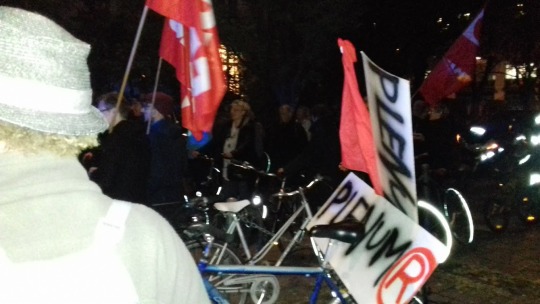
DIE LINKE sieht sich vorbehaltlos dem antifaschistischen Gedanken verpflichtet und steht mit Entschiedenheit für dessen gesamtgesellschaftliche Verankerung ein. Darum wollen wir uns kurz vor dem Wahlsonntag zusammen mit interessierten Münchener*innen in einer öffentlichen Diskussionsveranstaltung einen ersten Überblick darüber verschaffen, was in der nächsten Wahlperiode auf das Land zukommt. Insbesondere werden wir zu bestimmen versuchen, was für Folgen es hat, wenn die extreme Rechte an der lokalpolitischen Gestaltung des Alltags beteiligt ist – etwa wie deren Mitarbeit auch in scheinbar wenig kontroversen Verwaltungsangelegenheiten zu gefährlichen Diskursverschiebungen und dergestalt zu einer weiteren Normalisierung faschistischen Denkens, Sprechens und Handelns führen kann. Darüber hinaus stellt sich auch ganz konkret die Frage, wie sich etwa durch persönliche Vernetzungen möglicher Mandatsträger*innen der AfD mit sog. ‚Freien Kameradschaften‘, neo-nazistischen Kleinstparteien oder anderen gewaltbereiten Gruppierungen des rechten Spektrums deren Gefahrenpotenzial multiplizieren kann.
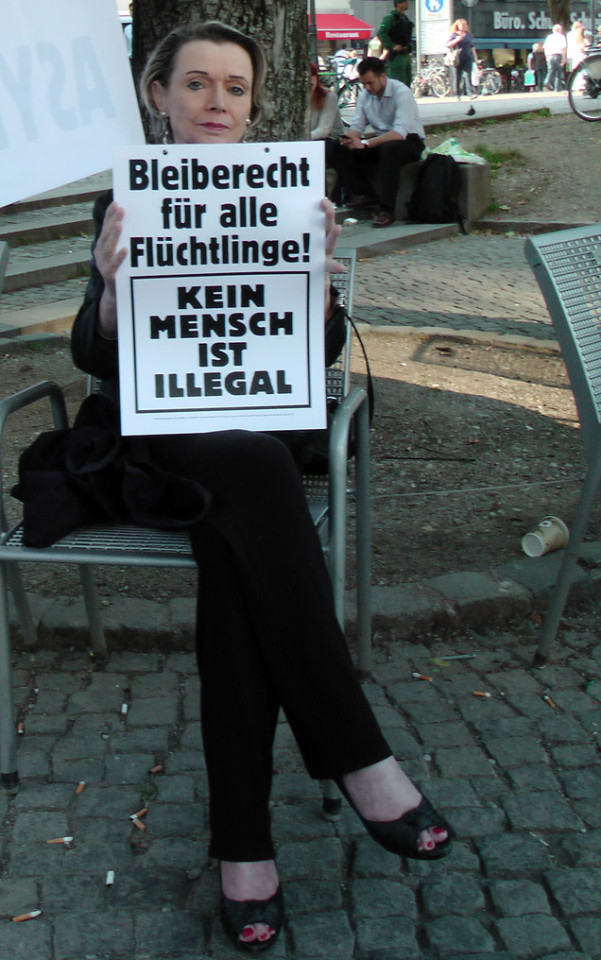
Als Münchener Kreisverband der LINKEN ist es für uns im Sinne der Ursachenforschung des Weiteren auch besonders relevant darüber zu diskutieren, wie gerade die spezifischen gesellschaftlichen Konflikte innerhalb des urbanen Raumes als Kausalfaktoren mitverantwortlich sind für das Entstehen rechtspopulistischer bzw. neofaschistischer Wahlerfolge. Dabei gilt es natürlich, die Wechselwirkungen mit überregionalen Organisationen der Faschist*innen nicht aus dem Blick zu verlieren. Mit zwei ausgewiesenen Kenner*innen der Materie – der LINKEN-Politikerin Katharina König-Preuss und dem Journalisten Tilo Giesbers – wollen wir in einem moderierten und für das Publikum offenen Podiumsgespräch all diese Themen anzusprechen versuchen. Zur Teilnahme eingeladen sind alle Menschen, denen genau wie uns als linker Partei die Frage auf den Nägeln brennt, wie sich adäquat auf das Erstarken rechter Kräfte reagieren lässt. Ein erster Schritt muss es diesbezüglich sein, sich der von AfD und anderen Rechtspopulisten betriebenen Begriffsverwirrung mit analytischer Schärfe entgegenzustellen und die Faschisten in aller Klarheit bei ihrem Namen zu nennen. Die Teilnehmer*innen auf dem Podium:

Katharina König-Preuss ist Mitglied der LINKEN-Fraktion im Thüringer Landtag und eine profilierte Kennerin der rechten Szene. Seit Jahren tritt sie durch ein breites antifaschistisches Engagement sowie thematische Publikationen an die Öffentlichkeit und gehört zu den bekanntesten Antifaschist*innen Deutschlands. Auch in ihrer Abgeordnetentätigkeit hat sie bereits mannigfaltige Erfahrungen im Umgang mit Rechten machen müssen. Besonders hervorzuheben ist ihre Teilnahme an den NSU-Untersuchungsausschüssen des Thüringischen Landtags, wodurch sie maßgeblich dazu beigetragen hat, Licht in diesen finsteren Abgrund der jüngsten Geschichte zu tragen. Tilo Giesbers konzentriert sich in seiner Beschäftigung als Autor und Journalist auf die Dokumentation des rechten Milieus in ganz Deutschland. Als Rechercheur und aktiver Antifaschist hat er Erfahrungen aus erster Hand sammeln können und unverzichtbare Einblicke in Methoden, Vernetzungsstrategien und Ideologie der Neofaschist*innen gewonnen. U.a. arbeitet er zusammen mit der antifaschistischen Informations-, Dokumentations- und Archivstelle München e.V. (a.i.d.a.). 2018 hat er zusammen mit Anika Taschke das Buch ‚Rät*innen gegen Rechts‘ bei der Rosa-Luxemburg-Stiftung veröffentlicht, das 2020 in aktualisierter Fassung erscheinen wird. Die Moderation übernimmt Christian Frühm, der für DIE LINKE. München zum Bezirksausschuss Au-Haidhausen kandidiert.
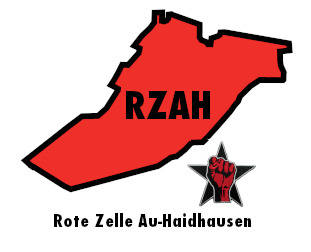

Christian Stupka Initiative für ein soziales Bodenrecht München Marina Dietweger LINKE-Stadtratskandidatin Platz 3Vom erfolgreichen Sozialprojekt bis zum Sündenfall, von gelungener Nachverdichtung bis zum zynischen Luxuswohnungsbau, vom tollen Ensemble genossenschaftlichen Wohnungsbaus bis zur skandalösen Preistreiberei bei Eigentumswohnungen. Spaziere mit uns vorbei an positiven Beispielen, die durch kluge Boden- und Vergabepolitik entstanden sind und erfahre direkt und sichtbar, was passiert, wenn die Stadt zum Höchstgebot verkauft und Investoren freie Hand haben. Wir lassen uns aber auch davon beeindrucken, wie genossenschaftlicher Wohnungsbau ganze Nachbarschaften positiv prägen kann. Mietenpolitischer Stadtteilrundgang SchwabingAm: Sonntag, 1. März um 14:00 Uhr Ort: Ecke Erich-Kästner-Straße/ Herzogstraße, U-Bahn Station Hohenzollernplatz“Ob Leerstand, Entmietung oder Nachverdichtung mit Luxuswohnungen. Schwabing ist seit Jahrzehnten eines der Zentrum der Gentrifizierung in München.Unser Spitzenkandidat für den Bezirksausschuss Schwabing West, Rudi Knauss und unser Stadtratskandidat auf Listenplatz 6, Christian Schwarzenberger, wollen mit einem Stadtteilspaziergang den Mietenwahnsinn sichtbar machen. Beide haben sich in den letzten Jahren bei der Bürgerinitiative #ausspekuliert engagiert. Berichten werden neben den beiden Mietenaktivisten auch betroffene Mieter*innen von ihren Kämpfen gegen Entmietung und Verdrängung.

wir möchten uns als AG Betrieb & Gewerkschaft aktiv am Stadtratswahlkampf beteiligen. am Dienstag, den 3. März, um 18:00 Uhr im Kreisbüro, Schwanthalerstraße 139. Tagesordnung: * Lage der Beschäftigten im Münchner Einzelhandel * Aktivitäten im Kommunalwahlkampf Für den Wahlkampf schlagen wir vor, in den Kaufhäusern an die Einzelhandels-kolleginnen anlässlich des Internationalen Frauentages (8. März) davor am Samstag, den 7.3. oder danach am Montag, den 9.3., Rosen zu verteilen (inkl. einem Wirtschafts-Flyer). Zur Einstimmung wird uns unser Spitzenkandidat Stefan Jagel einen Überblick über die Lage der Beschäftigten im Münchner Einzelhandel geben. Danach gehen wir in die konkrete Planung der Verteilaktionen. Nach der hoffentlich erfolgreichen Stadtratswahl am 15. März werden wir die Themenliste, die wir im der letzten AG-Treffen erstellt haben, abarbeiten. Auf zahlreiches Kommen freuen sich Eure AG-Sprecher*innen: Katharina Heymann, Ben Pulz, Wolfgang Schulz, Maren Ulbrich Thomas Lechner und andere legen auf am: Samstag, den 29. Februar 2020 ab: 22:00 bis 05:00 im Rote Sonne, Maximiliansplatz 5, 80333 München Thomas Lechner hat seit Anfang der 90er Jahre die Münchner Partylandschaft und Livekulturszene “aufgemischt”, aber auch Großdemos wie “ausgehetzt” mitorganisiert. Jetzt bewirbt er sich als Kandidat für den Posten des Oberbürgermeisters und den Stadtrat und möchte dort insbesondere Vielfalt in der Stadt stärken, solidarische Prozesse anstossen und jegliche Form von Diskriminierung bekämpfen. Kurz vor der Kommunalwahl am 15.3. soll am Beispiel einer Party deutlich gemacht werden, wie eine derartige Vielfalt gelebt werden kann. Ob zum Selbermachen, zum Erfahren oder zum Genießen – Kunst und Kultur sind nämlich ein wichtiges menschliches Grundbedürfnis. Kulturelle Betätigung bietet die Möglichkeit der Artikulation von Bedürfnissen und der Reflexion über die Welt. Ob soziale, geschlechts- oder altersbedingte Grenzen, ob von unterschiedlichen Seiten der Welt kommend – gemeinsames kulturelles Schaffen überwindet Barrieren und Grenzen. Kultur muss inklusiv sein. Ausgrenzende Kultur lässt Kultur schwinden. Wir streiten dafür, dass Menschen gemeinsam nicht nur Kultur “konsumieren”, sondern auch schaffen können, denn in München schwinden die Freiräume für kreative Entwicklungsmöglichkeiten zusehends, oft wird einer reinen Entertainment- und Eventökonomie das Feld überlassen. Wir wollen gemeinsam zeigen, dass das auch anders geht, wie wichtig das für unsere Stadt ist und vor allem: wie verdammt viel Spaß inklusive und diverse Kultur machen kann. Mehr dazu hier: Rote Sonne - Tanz den Bürgermeister Wem gehören die Fahrradstraßen? - Uns! Unter diesem Motto wollen wir am 07. März in Schwabing-West genüßlich und in unserer eigenen Geschwindigkeit die Fahrrad-straßen zurückholen. Wir machen deshalb eine Fahrradtour in dem Tempo, in dem bisher neue Fahrrad- infrastruktur gebaut wird, sehr langsam. Komm vorbei! Wir treffen uns am 7. März um 12:00 Uhr an unserem Boxenstopp in der Clemensstraße am Bavariapark. Von dort können wir je nach Lust und Laune die Schwabinger Runde auf ca. 3 km überwiegend Fahrradstraßen gemeinsam erkunden. Lasst uns zusammen mal den Raum nehmen, den uns Fahrradstraßen eigentlich einräumen, nämlich neben-einander fahrend, in unserem Tempo, unbehelligt vom KFZ. Auch diesmal sind wieder Rosenverteilaktionen unter anderen an Münchner Kliniken geplant. Dazu gibt es weitere Infos im nächsten Newsletter. Das Aktionsbündnis 8. März veranstaltet am 8. März ab 13:00 Uhr am Marienplatz einen "Frauen*wahlkampf*tag". Hier dazu mehr Informationen:Aktionsbündnis 8. März auf Facebook Terminankündigungen:* Do. 12. März: Mietenwahnsinn! Immobilienkonzerne enteignen? Veranstaltung im Heppel & Ettlich* So. 15. März: ab 18:00 Uhr Wahlparty im Stragula Read the full article
0 notes
Photo

Have you seen castles in person? Which has been your favorite? 📍Hlubokà, Czech Republic @the_leiover ・・・ ******* In Southern Bohemia, a few hours from Prague, lies one of the more beautiful castles you'll see. Hluboká nad Vltavou Castle is a neo-Gothic treasure, considered a must-see for any romantic and history lovers. 🇨🇿 At the site since the 13th century, Hluboká was reconstructed into a Baroque castle in the 18th century. It reached the zenith of its appearance in the 19th century when the castle was reconstructed to resemble the romantic stylings of Windsor Castle. 🇨🇿 The owners of the castle until 1939 were the Schwarzenberg Family. They had to escape Czech due to the Nazis and subsequently lost all their properties in 1947. Since then, Hluboká castle has been a Czech national treasure. 🇨🇿 Personally, I was awe struck at the beauty of the castle, the land it's on, the surrounding town, and the Czech countryside on the way here. I was fortunate to have my good friend from Prague, Diana (@diana_prague) offer- rather, insist- on taking me here. When I looked up Czech castles to visit prior to my Prague arrival, I figured this beauty was out of the question due to its distance. Diana surprised me by taking us here and as you can see, I was ecstatic. 🇨🇿 As you drive into the town, you'll park well below the hill the castle sits atop. The walk up takes you through the Renaissance village, past cute cafes offering Czech countryside cuisines (wild boar, venison), quaint hotels, and a beautiful church. The road side turns and takes you up a sharp incline dotted with trees and Orthodox Christian statues. Being there in November, I was treated to the sights of Autumn dotting the landscape with my favorite colors of the season.... (to be continued) 🇨🇿 . . . . . . #Prague #TopPraguePhoto #topeuropephoto #CzechRepublic #traveltagged #teamkaptainkenny #LovetheWorld #TLPicks #livetravelchannel #passportcollective #mytravelcrush #TravelNoire #agameoftones #moodygrams #Canonfanphoto #living_europe #loves_europe #loves_czech #bohemian #hluboka #castles #architecture_hunter #archiporn #architecture (at Hluboká Castle)
#prague#travelnoire#canonfanphoto#bohemian#living_europe#teamkaptainkenny#agameoftones#loves_europe#traveltagged#toppraguephoto#mytravelcrush#topeuropephoto#architecture_hunter#hluboka#loves_czech#czechrepublic#lovetheworld#architecture#archiporn#castles#moodygrams#passportcollective#tlpicks#livetravelchannel
0 notes
Text



Federal Knitting Mills Building
2882 Detroit Ave.
Cleveland, OH 44113
The Federal Knitting Mills Building is located at 2860-2894 Detroit Avenue in Cleveland, Ohio, also 2820 and 2811-21 Vermont Ave., and is listed on the National Register of Historic Places. Herbert G. (Goldberger) Goulder and Louis H. Hayes established the Federal Knitting Mills company in Cleveland in 1905. Within six months Louis L. (Seligman) Selden joined the company as a partner. The company, employing 75 people, was first located at a rented 10,000-square-foot loft at 600 Huron Road. Around 1910 the company relocated and became the sole occupant of a building at West 29th and Detroit. Little is known of the 1910 architect, Gustave B. Bohm. He was born in Cleveland around 1874 and educated in Cleveland's public schools. He attended Columbia University and was listed in Cleveland City Directories as an architect from 1901-1932 and died on April 15, 1934. The architects of the later additions, Christian-Schwarzenberg and Gaede Company, also designed the L.N. Gross Building.
When the building was constructed in 1910 the neighborhood was primarily residential, with commercial buildings lining Detroit east of West 28th Street, towards downtown Cleveland. The Franklin Circle Historic District (a Cleveland Landmark) remains an equal mix of residential and commercial buildings. The majority of the residential buildings are two-story wood-framed Victorians. Commercial buildings are two to three-story masonry structures. The Federal Knitting Mills Building is recognized as one of the few remaining commercial buildings of the Franklin Circle Historic District. The 1910-1915 commercial-style building was designed by local architect Gustave B. Bohm. Additional construction for the building, required during the construction of Interstate Route 2, was headed by the architectural firm of Christian, Schwarzenberg and Gaede Company in 1917. The building is a three-story masonry constructed building, with a small additional one-story in the northeast "L" of the building. The interior structure is wood post and steel-beam construction, with skylights and a clerestory on the third floor.
The Federal Knitting Mills Building is a Chicago Commercial style brick structure with stone decorative accents along the cornice. The building is a simple design, limited to detail in the fashion of the commercial style of the 1910s. Projecting piers between the bays minimizes the horizontal effect of the building. The facade faces Detroit Avenue, it is 44' high and carries 16 bays along Detroit Avenue. There are two entrances at the east and west end of the building on the south facade. The west elevation is similar to the south facade. The north elevation employs several entryways for delivery access. The east wall is a blank wall with limited projections suggesting the Chicago style. A large chimney extends upward along the northwest corner of the building. A large water-tower structure is located on the roof, the tank is missing.
The building is a three-story warehouse building with an open plan. The building is sixteen bays along the south elevation and ten bays deep to the north. There are several entrances into the building, two on the south elevation, one on the west, three on the north and three on the east. The building is a combination of masonry construction and steel and wood beams with wood piers. The roof is a rolled asphalt flat roof. The immense fenestration allows a great amount of light to fill the interior space. A photo dating from 1934 demonstrates the use of 1/1 double-hung wood windows in the sixteen bays that front Detroit Avenue. Alterations, sometime after 1994, blocked in a majority of the lower-level windows. Steel industrial windows are located throughout the window openings, based on the 1934 photo, these are replacement windows. An open interior court is located in the center of the building. The court has brick flooring and is enclosed on all four sides with an entrance to the east. The existing windows demonstrate alterations. Both steel industrial windows and wood 12/12 remain, in addition to the glass block and concrete blocked in areas.
The 115,672-square-foot building was constructed in four phases. The westernmost portion (approximately the first four bays) measuring 70' along Detroit by 192' along West 29th, was constructed in 1910. In 1915, an additional 4 bays was constructed to the east along Detroit, spanning a depth of 114' towards Vermont Avenue. The plan for these first two phases was designed by local architect Gustave B. Bohm. The last two phases of construction were administered by the architectural firm of Christian, Schwarzenberg and Gaede Company. Phase three of the building occurred in 1917. The change in the structure occurred in response to the construction of the nearby bridge to the north. The construction of the Detroit-Superior Bridge required the widening of Detroit Avenue in front of the Federal Knitting Mills, resulting in changes to the building. The widening of Detroit removed 34' of the existing southernmost face of the structure in effect the remaining surface of the structure fronting Detroit was refaced and an addition of 118" was constructed to the east along Detroit, sharing a common face. The last substantial phase of additions transpired in 1921, when Federal Knitting Mill enlarged the complex to 93' along Vermont Avenue with a depth of 93'.
The firm was incorporated in 1926 and by 1928, the firm employed 650 people. Over 100,000 pieces of knitwear were produced each week. Federal Knitting Mills made sweaters, bathing suits, caps, dresses, shawls, scarves, knitted headwear, and many knitted novelties. It also exported knitted lace for Spanish shawls that were sold to tourists in Manila. The products were wholesaled to jobbers (middlemen) and also through Federal Knitting Mills' own agency in New York City, which controlled worldwide distribution. The company's customers included well-known department stores and mail-order houses, including Marshall Field, Sears Roebuck, Montgomery Ward, and Carson Pirie Scott. The Federal Knitting Mills continued to flourish during the Great Depression and sales reached a peak of $2,782,418 in 1932. That year the company had the best record of all issues listed in the Cleveland Stock Exchange. Production records were set in 1934 and bonuses continued to be given out as late as December 1936.
The Federal Knitting Mills thrived for twenty-seven years as a major economic force in the garment industry. The building continued to be utilized by garment companies for years after the liquidation of the Federal Knitting Mills. The Gottfried Company (Marie Dressler and Mynette dresses), a dress manufacturer occupied the building through the 1940s. The S. Weitz and Company, cloth manufacturers, occupied the building from 1940-1956; their printed sign is still visible on the building. The Barton Knitting Mills occupied the building through the 1950s-60s. From the 1950s to the 1990s, smaller and varied businesses occupied the building, including the Deltronix Corporation and the Glasier Casket Company, both of the 1960s-90s. Originally, the building opened as the Federal Knitting Mills Building, but was sold to the Seaway Company in the 1960s. Now, the building has been rehabilitated for residential use, maintaining the significant historic elements.
Little of the original structure's exterior designed by Bohm remains, only a portion of the west wall. The entrance to the lower level of the Detroit-Superior Bridge was directly in front of the building, explaining the width of the street at this point. Streetcars utilized this entrance from 1917-1955, it has since been closed and covered. Significant architectural features can be identified as the central courtyard, the stone accents at the parapet and the extensive use of fenestration, monitor windows and skylights. The existing conditions of the building are good. The exterior brick demonstrates the usual sign of air pollution. The existing wood and industrial steel sash windows demonstrate neglect. The skylights display deterioration while the majority of the monitor windows are in good condition, minus the overuse of tar. In general the building is of a simple design and lacks architectural details. There’s nothing else like it in Cleveland. The historic Federal Knitting Mills Building, now converted to state-of-the-art, one- and two-bedroom industrial-style lofts with open floor plans, high ceilings, polished concrete floors, exposed ductwork, high-quality gas kitchens, and sweeping views. Housed in an old-world exterior, these sleek, new-world lofts offer contemporary interiors with unparalleled comfort, privacy, and value.
0 notes
Text
„Ismeretlen” vértanúk a szabadságharc után
Az 1848–49-es forradalom és szabadságharc legismertebb vértanúiként az Aradon kivégzett tábornokokat és Batthyány Lajost, az első magyar miniszterelnököt tartja számon a közvélemény. Az ő mártírhaláluk kétségtelenül a megtorlás csúcsa volt, ám rajtuk kívül is száznál több katonatisztet, politikust és polgári személyt végeztek ki az osztrákok. A megtorlás ráadásul 1849 januárjában megkezdődött; az év első felében a kivégzések a civil lakosság megfélemlítését és elrettentését célozták, nyártól és a világosi fegyverletétel után viszont a katonai és a polgári vezetéssel való leszámolás volt az osztrákok szándéka.
Agyonlőtték a színházi súgót
– Az 1848 decemberétől kibocsátott kiáltványokban az udvar már jelezte, a szabadságharc résztvevői semmi jóra nem számíthatnak. Csupán az volt kérdéses, milyen kört érint az osztrákok bosszúja – mondta lapunknak Hermann Róbert történész, a Hadtörténeti Intézet és Múzeum parancsnokának tudományos helyettese. – Eleinte nem főtiszteket és politikusokat végeztek ki, hanem civileket: földműveseket, falusi tanítókat, papokat, földbirtokosokat, akiknek az volt a bűnük, hogy lázítottak, kocsmákban iszogató császári katonákat próbáltak rábírni arra, hogy álljanak a magyar szabadságharc ügye mellé – ezt pedig Pelyach István történész, a Szegedi Tudományegyetem tudományos munkatársa fűzte hozzá. A megtorlás egyik első áldozata Daniel Christian Dressler, a pozsonyi német színház súgója volt.
A pozsonyi kocsmákban enyhén illuminált állapotban szidta Ferenc Józsefet, a trónbitorlót, a Habsburgokat, és kiállt a magyarok mellett. Aztán besúgók feladták, majd hadbíróság elé állították, és 1849. január 18-án reggel 7 órakor végrehajtották rajta a halálos ítéletet
– mutatta be egy példával Pelyach István, milyen „bűnökért” járt halálbüntetés még jóval Haynau 1849. május 30-i színre lépése előtt.
Kivégzés a kormány szidalmazásáért
Hasonló eseteket Hermann Róbert is felsorol a megtorlással foglalkozó munkáiban. „(1849) Március 27-én Giovanni Baldini vasúti mérnököt, a többnyire olaszokból alakult Frangepán-csapat főhadnagyát lőtték agyon az olasz legénységű 23. (Ceccopieri) gyalogezred tagjainak magyar oldalra csábításáért, valamint fegyveres felkelésben való részvételért. Március 30-án pedig Barta Józsefet, Simonyi Ernő gerillacsapatának őrmesterét állították kivégzőosztag elé fegyveres lázadásban való részvételért, valamint a verebélyi sópénztárban található pénzösszeg elrablásáért (…) Másnap lőtték agyon Csömy Zsigmond aranyosi molnárt az uralkodó és a kormány szidalmazásáért, valamint fegyverrejtegetésért. Február 6-án a lengyel Feliks Slawsky szabót végezték ki, mert január 30-án több cs. kir. katona szállásán »őfelsége a császár ellen a legdurvább és legingerlőbb rágalmakat szórta«, s e katonákat »hitszegésre is csábítani igyekezett«” – ezeket az eseteket Az 1849–1850. évi kivégzések című tanulmányában említi Hermann Róbert.
A megtorlás jellege 1849 nyarától Haynau kinevezésével megváltozott. A hadifogságba esett főtiszteket kivégeztette az osztrák csapatok parancsnoka. Július 5-én Pozsonyban felakasztatta Mednyánszky László honvédőrnagyot és Gruber Fülöp századost. Hermann Róbert tanulmánya szerint
„kivégzésük valósággal sokkolta a magyarországi közvéleményt. (…) Mednyánszky báró volt, s az ilyen magas társadalmi állású személyeket az osztrák hadbíróságok eleddig legfeljebb börtönbüntetésben részesítették.”
Haynau fővezérségével megszaporodtak a rögtönítélő eljárások. A számtalan példa közül csak egy a hivatkozott tanulmányból: 1849. július 12-én Mannsbarth Antal csákberényi katolikus plébánost és Szikszay János ottani református lelkészt végezték ki rögtönítélettel Nagyigmándon. „A két pap bűne az volt, hogy a szószékről a magyar kormány rendelete értelmében kihirdették a Függetlenségi Nyilatkozatot, s állítólag népfelkelésre, s arra hívták fel híveiket, hogy fegyver híján kövekkel verjék agyon a betolakodókat” – írja Hermann Róbert.
„Felakasztattam egy Auffenberg nevű egyént”
1849. augusztus 22-én halt mártírhalált az az Ormai (Auffenberg) Norbert, akit az első aradi vértanúnak tekintenek, mivel ezredesi rangban szolgált, és őt is a partiumi városban végezték ki. Ormai az úgynevezett vadászezredek főfelügyelője és az 1. honvéd vadászezred megszervezője volt. Haynau nem is csinált titkot abból, hogy a vele szemben foganatosított eljárást alkalmazza majd a későbbi vértanúk esetében. „Tegnapelőtt megkezdődött a dolog, felakasztattam egy Auffenberg nevű egyént, aki valamikor hadnagy volt a Mazzuchelli-ezredben, aztán ezredes és Kossuth segédtisztje. Kiss, Leiningen, Poeltenberg, Vécsey stb. is követni fogja, mihelyt megérkezik. Az eljárás a lehető legrövidebb lesz, megállapítjuk az illetőről, hogy tisztként szolgált nálunk, és fegyveres szolgálatot teljesített a lázadó hadseregben” – írta egy osztrák tábornoknak küldött levelében.
A megtorláspárti fiatal császár
Pelyach István szerint az augusztus 13-i világosi fegyverletétel után fogságba került főtisztek, tábornokok számára a halálos ítélet eleve elrendelt volt. A szakember hangsúlyozta, aki az osztrákok szerint felségárulást követett el, annak csak halálos ítélet lehetett a büntetése. De Haynauhoz hasonlóan megtorláspárti volt-e a fiatal uralkodó, Ferenc József? Ezt a kérdést Hermann Róbertnek tettük fel, aki úgy válaszolt, egyértelműen igazolható, hogy még olyan esetekben is, amikor Schwarzenberg miniszterelnök hajlamosabb lett volna enyhébb elbírálásra, Ferenc József döntött a keményebb megtorlás mellett. Az 1849. augusztus 20-án, az ifjú uralkodó elnökletével tartott minisztertanácson született döntés arról, hogy nem lesz amnesztia, hanem – a történész szavai szerint – a megtorlás teljes szigorával fognak fellépni a magyar szabadságharc résztvevői ellen.
Az 1849. október 6-án végrehajtott kivégzések – az aradi vértanúké és különösen Batthyány Lajosé – azonban óriási nemzetközi felháborodáshoz vezettek. Ráadásul a tábornokok és a volt miniszterelnök halálos ítélete előre készen állt.
Batthyány esetében Hermann Róbert arra hívta fel a figyelmet, pere száz sebből vérzett, illetve annyira próbálkoztak azzal, hogyan lehet ezt az egyébként semmilyen szempontból felelősnek nem tekinthető miniszterelnököt elítélni, hogy ez 20. századi szempontból nézve is koncepciós per volt.
Pelyach István ehhez hozzátette, nyilvánvaló volt, hogy Batthyányt halálra szánják, pere eleve lejátszott volt.
Tizenhat aradi vértanú
Kevésbé ismert, hogy az október 6-án kivégzett tábornokok és Ormai (Auffenberg) Norbert mellett az aradi vértanúk közé sorolják még az október 25-én agyonlőtt Kazinczy Lajos ezredest, a nyelvújító író-költő, Kazinczy Ferenc fiát. Az ő kivégzésével ért véget az 1849. évi megtorlás, amit az osztrákok a nemzetközi tiltakozás hatására állítottak le. Legalábbis a politikai szempontú kivégzéseket, mert köztörvényes színezetű ügyekben 1850-ben is hajtottak végre halálos ítéleteket, az utolsót 1850 júliusában – hívta fel a figyelmet Hermann Róbert. De még ebben az évben is akadt egy politikai ügy, amelynek végén egy volt bécsi újságírót, a szabadságharcban Bem József mellett alezredesként szolgáló Ludwig Haukot végezték ki. Bár a hadbíróság halálra ítélte, Schwarzenberg miniszterelnök mégis 20 évi várfogság kiszabását javasolta rá, mondván, közben úgyis meghal. Mint Hermann Róbert írja, Haynau azonban nem hallgatott Schwarzenbergre, és Haukot 1850. február 19-én Aradon felakasztották. Ő volt a tizenhatodikként kivégzett honvédtiszt.
A megtorlás egyéb formái
A kivégzések mellett a megtorlásnak más formái is léteztek. Ilyen volt a várfogság, a sáncfogság (erődítési munkákban való részvétel), a volt honvédek tömeges besorozása, illetve a botozások, vesszőzések. Hermann Róbert megemlítette: nem volt gyakori, de néhány esetben előfordult, hogy az osztrák vagy az orosz csapatok feldúltak egy-egy települést. A Csorna melletti Bősárkány lakóit például azzal vádolták, hogy a csornai ütközet (1849. június 13.) után megtámadták a menekülő császáriakat – ami nem volt igaz –, ezért felgyújtották a falut. Losoncon 1849 augusztusában magyar gerillák támadtak meg oroszokat, mire a cári csapatok feldúlták és felégették a várost. A megtorlás része volt, hogy egy felkelés miatt Székesfehérvárra, a magyarok támogatásért pedig a zsidó hitközségekre vetettek ki hadisarcot az osztrákok.
Csapás a gazdaságra
– A nemzetet ért legnagyobb megtorló intézkedés az volt, hogy 1849 őszén begyűjtötték és megsemmisítették a szabadságharc fizetőeszközét, a Kossuth-bankókat – mondta Pelyach István. Ez a lépés ugyanis gyakorlatilag lenullázta a gazdaságot. A Kossuth-bankók be nem szolgáltatásáért és rejtegetéséért ráadásul szigorú büntetés járt.
Szintén csapást jelentett az országra, hogy 1850 tavaszától a birodalmi adópolitikát alkalmazták Magyarországon. A szabadságharc alatt gyakorlatilag nem létezett adózás a fegyveres önvédelem miatt. Ezért a kőkemény birodalmi adórendszer azt jelentette, hogy lényegében minden után adózni kellett.
Hogyan lett Görgeyből „áruló”?Az 1848–49-es forradalom és szabadságharc utáni megtorlás egyik legnagyobb kérdése, hogyan kerülhette el a halálbüntetést a magyar sereg főparancsnoka, Görgey Artúr. Pelyach István ezzel kapcsolatban elmondta: Görgey meg volt győződve, hogy ő lesz a megtorlás első számú célpontja, azt is mondhatjuk, hogy készült valamiféle mártíromságra. Tragédiája tulajdonképpen pont az lett, hogy nem végezték ki, mert ezzel vált alkalmassá arra, hogy az áruló szerepét betöltse a magyar közgondolkodásban. Görgeynek az oroszok többször is próbáltak csapdát állítani, de mindig kijátszotta őket – ez is bizonyította hadvezéri rátermettségét. – Ez a harmincadik életévét betöltő magyar tábornok valami olyasmit tudott, amit nagyon kevesen tudtak ebben a korban Európában – mondta hadvezetői képességeiről Pelyach István. I. Miklós orosz cár értékelte is ezt, ezért arra kérte Ferenc Józsefet, adjon kegyelmet, és bocsásson meg a magyaroknak. „Megbocsátunk, de előtte akasztunk egy kicsit” – szólt a császár és Schwarzenberg miniszterelnök hírhedtté vált válasza. A cár erre kikötötte, hogy ha nem garantálják Görgey életét, nem fogják kiadni őt az osztrákoknak. A bécsi udvar végül fogcsikorgatva ugyan, de belement ebbe; így Görgeynek nem esett bántódása, a karintiai Klagenfurtba száműzték. – Életét egyértelműen az oroszoknak köszönheti. Éppen elég tehertétel volt számára, hogy árulónak bélyegezték – összegezte sorsát Pelyach István. (A. V.)
„Ismeretlen” vértanúk a szabadságharc után a Nemzeti.net-en jelent meg,
0 notes
Text
The Crows of Leipzig
During a recent visit to Leipzig I was taking a walk in Clara Zetkin Park and encountered a powerful natural phenomenon and perhaps a symbol of something more.
I first noticed the sound of birds whilst walking through the South West corner of the park, it was very noticeable, although appeared to be from some distance away.
As I noticed the source of the sounds I was shocked by the sheer quantity of crows in flocks. The flocks I saw from across the park numbered in the hundreds of birds and still flock after flock could be seen flying over the trees in the distance. I hoped to be able to get a closer view but expected that they were just migrating across the park.
However, as I approached I found that approximately 1km from where I first heard them, In the South East corner of the park, the flocks of crows were settled in the trees. The flocks I had seen were not just a single flock flying around the park, they had all been individual flocks of hundreds of birds and the total number of birds now numbered in the thousands.
Every black dot in the image below is a crow.

Every black dot in the video of a different view is a crow and listen to the caws:
youtube
Every black dot in this video of a different view is a crow and listen to the caws:
youtube
The crow is a powerful mythological symbol through the ages.In Celtic mythology, the warrior goddess known as the Morrighan often appears in the form of a crow or raven, or is seen accompanied by a group of them. What would a group of hundreds or thousands mean?
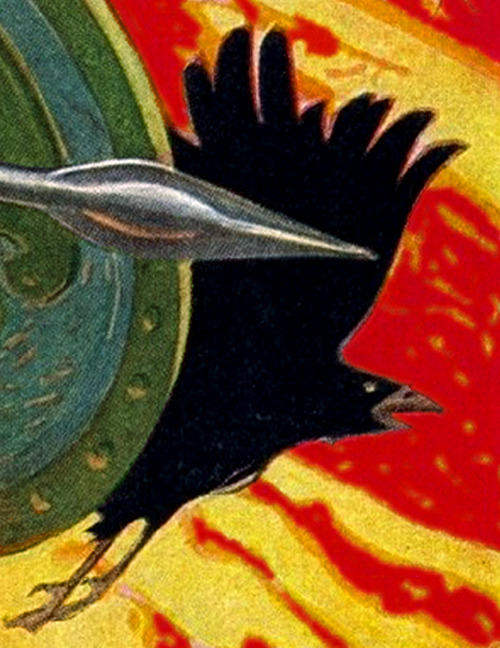
Typically, these birds appear in groups of three, and they are seen as a sign that the Morrighan is watching – or possibly getting ready to pay someone a visit. Imagine then the symbolism or the multitude witnessed. In some tales of the Welsh myth cycle, the Mabinogion, the raven is a harbinger of death. Witches and sorcerers were believed to have the ability to transform themselves into ravens and fly away, thus enabling them to evade capture. Were the crows a representation of a gathering or movement of those rich in magic. The Native Americans often saw the raven as a trickster, much like Coyote.

There are a number of tales regarding the mischief of Raven, who is sometimes seen as a symbol of transformation. In the legends of various tribes, Raven is typically associated with everything from the creation of the world to the gift of sunlight to mankind. Some tribes knew the raven as a stealer of souls. Perhaps that they follow the souls of the dead, in which case in Clara Zetkin Park I stood amongst hundreds, possibly thousands of lost souls. For those who follow the Norse pantheon, Odin is often represented by the raven �� usually a pair of them. Early artwork depicts him as being accompanied by two black birds, who are described in the Eddas as Huginn and Muinnin. Their names translate to “thought” and “memory”, and their job is to serve as Odin’s spies, bringing him news each night from the land of men. Perhaps this great flock was a gathering of Odin’s informants.

Crows sometimes appear as a method of divination. For the ancient Greeks, the crow was a symbol of Apollo in his role as god of prophecy. Augury – divination using birds – was popular among both the Greeks and the Romans, and augurs interpreted messages based on not only the color of a bird, but the direction from which it flew. A crow flying in from the east or south was considered favorable. All the flocks I had seen were flying into the park from the South East, so perhaps this was a positive indication. In parts of the Appalachian mountains, a low-flying group of crows means that illness is coming – but if a crow flies over a house and calls three times, that means an impending death in the family. If the crows call in the morning before the other birds get a chance to sing, it’s going to rain.
Despite their role as messengers of doom and gloom, it’s bad luck to kill a crow. If you accidentally do so, you’re supposed to bury it – and be sure to wear black when you do! In some places, it’s not the sighting of a crow or raven itself, but the number that you see which is important. Mike Cahill at Creepy Basement says, “Seeing just a single crow is considered an omen of bad luck. Finding two crows, however, means good luck. (Three crows mean health, and four crows mean wealth.) Yet spotting five crows means sickness is coming, and witnessing six crows means death is nearby.” So what would be the meaning of hundreds or thousands? Even within the Christian religion, ravens hold a special significance. While they are referred to as “unclean” within the Bible, Genesis tells us that after the flood waters receded, the raven was the first bird Noah sent out from the ark to find land.

Also, in the Hebrew Talmud, ravens are credited with teaching mankind how to deal with death; when Cain slew Abel, a raven showed Adam and Eve how to bury the body, because they had never done so before. Are the crows spiritual guides.

The most common feature of this research is that the crow is connected in some way to the human spirit, as some form of guide, be it to a higher spiritual being, for the soul, to indicate good from bad, right from wrong, as a messenger to or from God. Whatever the deeper spiritual meaning or symbolism of the crow, it is clear that the crow has a legacy of mythology that dates from the beginning of understanding story sharing.
Battle of Leipzig
The Battle of Leipzig or Battle of the Nations was fought from 16 to 19 October 1813, at Leipzig, Saxony. The coalition armies of Russia, Prussia, Austria, and Sweden, led by Tsar Alexander I of Russia and Karl Philipp, Prince of Schwarzenberg, decisively defeated the French army of Napoleon I, Emperor of the French. Napoleon’s army also contained Polish and Italian troops, as well as Germans from the Confederation of the Rhine. In the painting by Alexander Sauerweid the Russian, Austrian, and Prussian troops gather in Leipzig.

The battle was the culmination of the 1813 German campaign and involved nearly 600,000 soldiers, making it the largest battle in Europe prior to World War I.
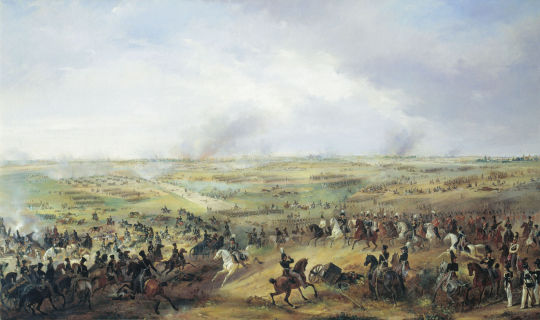
Decisively defeated for the first time in battle, Napoleon was compelled to return to France while the Coalition hurried to keep their momentum, invading France early the next year. Napoleon was forced to abdicate and was exiled to Elba in May 1814.
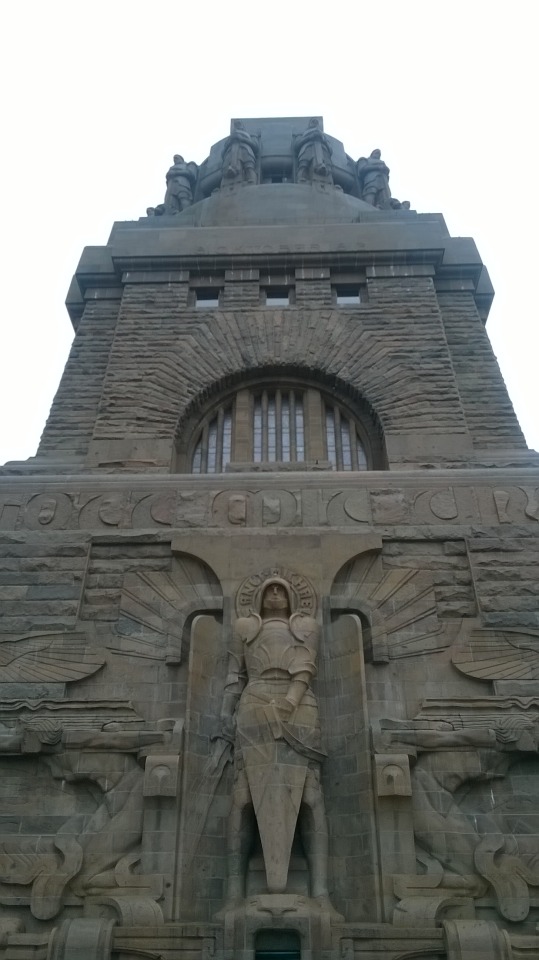
The battle of Leipzig was the bloodiest in the history of the Napoleonic Wars. Casualties on both sides were astoundingly high, such that even locals had a hard time disposing of the corpses, and even then the corpses were still visible the next year. Estimates range from 80,000 to 110,000 total killed, wounded or missing.

Napoleon lost about 45,000 killed and wounded. The Allies captured 15,000 able-bodied Frenchmen, 21,000 wounded or sick, 325 cannon and 28 eagles, standards or colours, and had received the men of the deserting formerly pro-French German divisions. Among the dead was Marshal Józef Antoni Poniatowski, a nephew to the last king of Poland, Stanisław August Poniatowski. The Pole, who had received his marshal’s baton just the previous day, was commanding the rear guard during the French retreat and drowned as he attempted to cross the river. Corps commanders Lauriston and Reynier were captured. Fifteen French generals were killed and 51 wounded.

Out of a total force of 430,000, the Allies suffered approximately 54,000 casualties. Schwarzenberg’s Bohemian Army lost 34,000, Blücher’s Silesian Army lost 12,000, while Bernadotte’s Army of the North and Bennigsen’s Army of Poland lost about 4,000 each.

Are the crows of Leipzig the remnants of souls still lost or refusing to leave? A memory of the 100,000 who lost their lives in the Battle of Nations.
German Democratic Republic
Another possibility comes from the coincidence that the crows gathering place was directly opposite the GDR famous Gaste Haus of Leipzig, or Honecker’s Palace, where only the most high profile East German government politicians would stay by invitation only.

This guest house was a retreat for the politicians who likely informally deciding policies and important government activities whilst enjoying the finest hospitality. This led me to the thought that the crows could be following the souls of those who lost their life under the GDR.
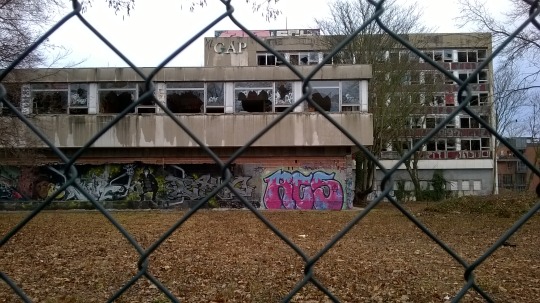
East Germany abolished the death penalty in 1987. The last execution in East Germany is believed to have been the shooting of Werner Teske, convicted for treason, in 1981; the last execution of a civilian (after 1970, capital punishment was rare and almost exclusively for espionage) was Erwin Hagedorn, for sexually motivated child murder.
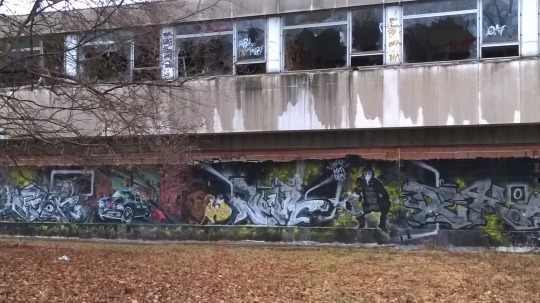
By then, East German courts had inflicted the death penalty in 227 cases. 166 were executed, of which 52 for assumedly political crimes (espionage, sabotage etc.), 64 for crimes under Hitler’s rule and 44 for common criminality (mostly, murder under aggravated circumstances). Most of these took place during the 1950s; three known executions took place in the 70s and two in the 80s.

The guillotine (called the Fallschwertmaschine, “falling sword machine”) was used for the last time on former SS doctor Horst Fischer in 1966, after which it was replaced by an “unexpected close shot in the back of the head” (“unerwarteter Nahschuss in das Hinterhaupt”).
Berlin Wall Deaths
Another possible explanation for the crows is that these are connected to the residual spiritual remnants of those who lost their lives escaping from the GDR. This is again related to the GDR politicians who stayed at the guest house.
There were numerous deaths at the Berlin Wall, which stood as a barrier between West Berlin and East Germany from 13 August 1961 until 9 November 1989. Before the rise of the Berlin Wall in 1961, 3.5 million East Germans circumvented Eastern Bloc emigration restrictions, many by crossing over the border from East Berlin into West Berlin, from where they could then travel to West Germany and other Western European countries. Between 1961 and 1989, the Wall prevented almost all such emigration.
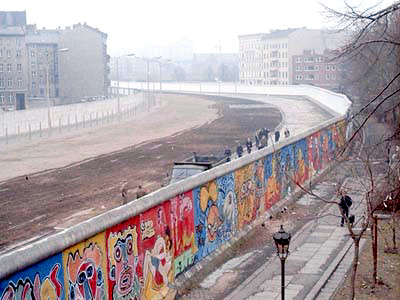
The state-funded Centre for Contemporary History (ZZF) in Potsdam has given the official figure of 139 deaths, including people attempting to escape, border guards, and innocent parties. However, researchers at the Checkpoint Charlie Museum and some others had estimated the death toll to be significantly higher.
The escape attempts claimed the lives of a wide variety of people, from a child as young as one to an 80-year-old woman, and many died because of the accidental or illegal actions of the guards. In numerous legal cases throughout the 1990s, several border guards, along with political officials responsible for the defence policies, were found guilty of manslaughter and served probation or were jailed for their role in the Berlin Wall deaths. Out of an estimated number of 5,000 escapees, a total of 239 people died while trying to cross the Berlin Wall.
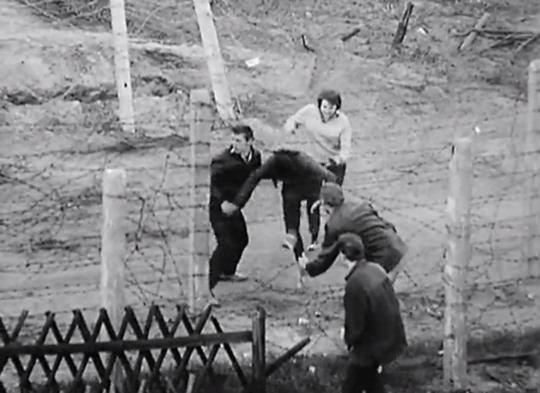
The exact number of casualties is unknown.
There are different numbers that each derive from different investigations that used different definitions of what a victim in this case should be. Therefore, the numbers are hardly comparable. On top of that, some results are published infrequently or investigations were ceased with a provisional number. There is also a publicly held controversy between two groups regarding the number of victims. The opponents are the Arbeitsgemeinschaft 13th August and the ZZF. The former's numbers are higher, as they include, according to ZZF's Hans-Hermann Hertle, victims with an unclear or unsure connection to the border regime.
After the ZZF published its interim results in August 2006, Alexandra Hildebrandt of the Arbeitsgemeinschaft has accused them of withholding numbers to invoke a more positive picture of East Germany. She argues that the ZZF project was funded by a coalition of social democrats and leftists.

In 2008 the Arbeitsgemeinschaft claimed that since 1961 222 people had died because of the Berlin Wall. Hertle doubted these numbers, as they evidently included some survivors. As of 2006, 36 survivors were listed as deceased because of the Wall, and some victims were mentioned more than once. Because of these shortcomings, he assessed the list as an "extensive record of suspected cases" that "failed to set up a scientifically verifiable standard".
Berlin's Governing Mayor Klaus Wowereit commented on the dispute with the words "Every single dead was one too many." In 2009, Hildebrandt reported of 245 dead caused by the Wall. According to her research, the first Wall victim was a suicidal GDR officer and not Ida Siekmann, as Hildebrandt also included border guards that committed suicide and cold cases of bodies found in boundary waters in her list. Another difference in Hertle's and Hildebrandt's list can be explained by the fact that Hertle had additional access to incomplete files from transport police. Therefore, their accounts vary in regard to the people that died of natural causes during border controls. Hurtle argues with a total of 251 of such cases, while Hildebrandt only compiled 38 of these cases.
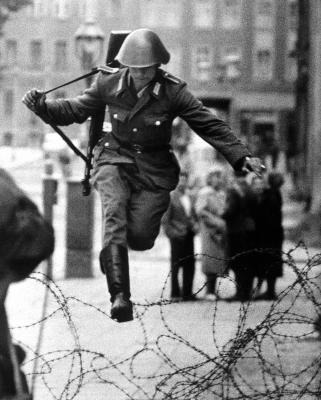
Information on the dead can be found mainly in the administrative and military archives of West and East Germany. However, the records of Stasi, which were administered by the Stasi federal commissioner, are not completely accessible. Some parts, especially from the later years, were destroyed when the ministry was disbanded, some are not yet sifted.
Additionally, due to the Stasi records law, many records can only be looked at in the form of anonymized excerpts. An amendment from 2007 allows direct access to research projects, provided certain conditions are met. The East German Border Troop records are kept at the Bundeswehr archive, as the border troops were part of the East German National People Army. According to Hertle, when border troop, Stasi and the records from Western authorities are evaluated, one has to take into account the "values, interests and constraints of the record-keeping authorities and, by extension, of the respective power relations." The families of the victims can be another source, but were often fed with false information and therefore can only seldom answer questions regarding the events themselves.

In this analysis of the spiritualism of the crows, I recall to memory famous artistic representations of this relationship between soul and crow in The Crow.
https://en.wikipedia.org/wiki/The_Crow_(1994_film)

youtube
There is also the superb, crow focussed graphic representation in Jeepers Creepers:
https://en.wikipedia.org/wiki/Jeepers_Creepers_(2001_film)
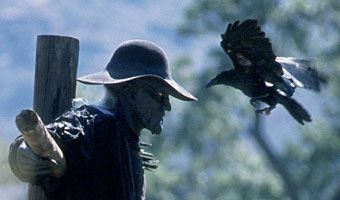
youtube
This was so successful that Jeepers Creepers 2 and 3 followed.
https://en.wikipedia.org/wiki/Jeepers_Creepers_2
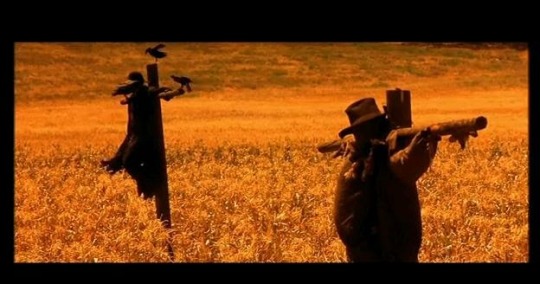
youtube
https://en.wikipedia.org/wiki/Jeepers_Creepers_3
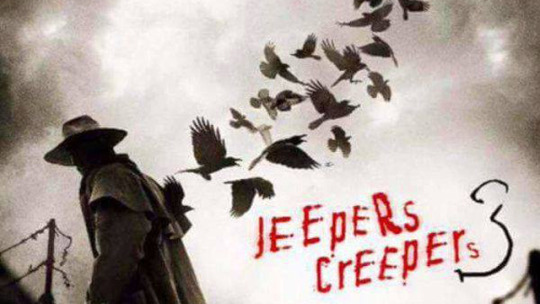
https://www.youtube.com/watch?v=0vMwquLRAFk
Whatever your belief in the reason for the crows, the power of their ancient symbolism is intense and intrinsic to the human soul beyond life.
Is it fate or coincidence the location of so many crows?
Is it fate or coincidence that the evening I was completing the curation of this blog I was watching the X-Files, complete series, as I had done for a number of months preceeding. I had watching 6 seasons and was up to the 16th episode of season 7; Chimera.
Mulder investigates what appears to be the case of a missing woman from a small town, but soon turns out to be a murder by a spirit summoned from the underworld.
https://en.wikipedia.org/wiki/Chimera_(The_X-Files)

In Bethany, Vermont, a raven frightens a little girl, Michelle Crittendon, at a park while a neighbour, Jenny Uphouse, watches. The bird is later found at her home. Her mother, Martha Crittendon, is then attacked and killed by an unseen monster. Walter Skinner (Mitch Pileggi) tells Mulder that Crittendon disappeared and asks him what he knows about ravens. Mulder believes that the bird is usually associated with evil. Ellen Adderly, the wife of Sheriff Phil Adderly, is approached by Jenny and then sees a raven before the window of a nearby car shatters. At the Crittendon home, Michelle sees the raven outside her window again and Howard leaves to check it out, leading him to find a hand sticking out above the flower bushes. Later the police dig up Martha's body, with claw marks all over her face.
Ellen tells Mulder that she saw a reflection in the mirror earlier, and that's what killed Martha. Mulder believes the glass are doorways to a demonic dimension and that someone is summoning forth a demon to attack people. Ellen believes Jenny Uphouse summoned the spirits, but she denies it. Later, Ellen finds a skeleton key in her house and a raven by her baby's crib. In a mirror, Ellen sees the reflection of a monster chasing after her, but it suddenly breaks. She hides in the closet until Phil comes home and finds her. However, he attributes the commotion to stress, believing that she is imagining things. Mulder finds the skeleton key and it matches one found in Martha Crittendon's coat pocket. At the motel, Jenny sees ravens outside and is promptly attacked and killed by the creature.
https://www.youtube.com/watch?v=7hnZqgCVTF8
Whatever your belief in the reason for the crows, the power of their ancient symbolism is intense and intrinsic to the human soul beyond life.
Is it fate or coincidence the location of so many crows?
Fate or coincidence, all these other deliberations?
You decide?
#crow#crows#leipzig#celtic#raven#native american#clara zetkin#odin#christianity#genesis#noah#battle of nations#battle of leipzig#napoleon#gdr#ddr#german democratic republic#east germany#berlin wall#the crow#jeepers creepers#x files#symbolism
0 notes